Contents
- 1. User Manaul
- 2. User Manual
User Manual
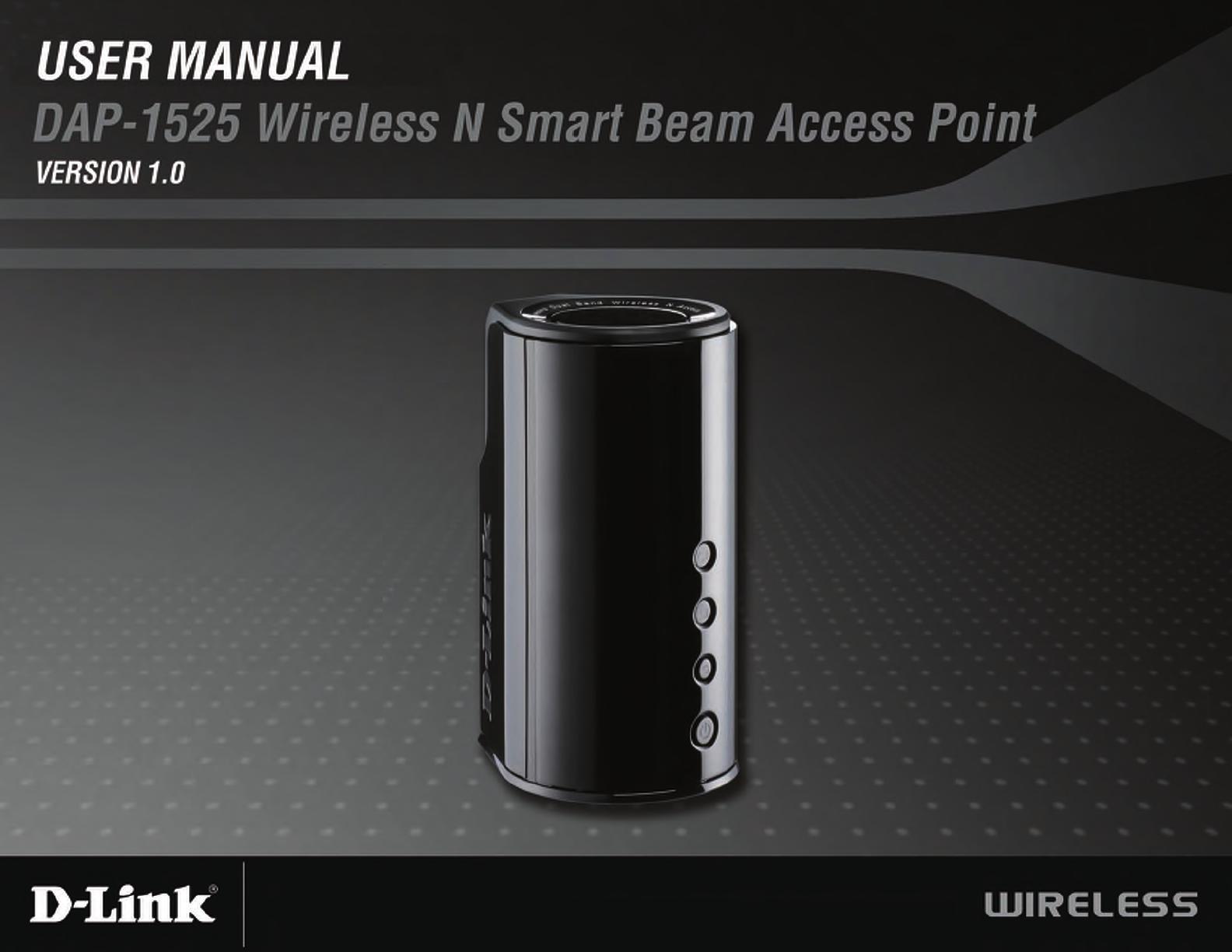
DAP-1525, DAP-1525A1
WiFi Booster smart beam AP
Wireless N 智慧型天線無線基地台

iD-Link DAP-1525 User Manual
D-Link reserves the right to revise this publication and to make changes in the content hereof without obligation to
notify any person or organization of such revisions or changes.
Trademarks
D-Link and the D-Link logo are trademarks or registered trademarks of D-Link Corporation or its subsidiaries in the
United States or other countries. All other company or product names mentioned herein are trademarks or registered
trademarks of their respective companies.
Copyright © 2011 by D-Link Systems, Inc.
All rights reserved. This publication may not be reproduced, in whole or in part, without prior expressed written permission
from D-Link Systems, Inc.
Preface

iiD-Link DAP-1525 User Manual
Table of Contents
Preface...........................................................................i
Trademarks .............................................................. i
Product Overview ........................................................ 1
Package Contents ...................................................1
System Requirements ............................................. 1
Introduction ..............................................................2
Features .................................................................. 3
Hardware Overview ................................................. 4
Back View ..........................................................4
Front View .......................................................... 5
Hardware Overview ................................................. 6
Bottom View ....................................................... 6
Installation ....................................................................7
Wireless Installation considerations ........................7
Connection - AP Mode ............................................8
Connection - Bridge Mode .......................................9
One Touch AP Conguration ................................. 10
Conguration ............................................................. 11
Web-based Conguration Utility for AP Mode ....... 11
Setup Wizard ................................................... 12
Wireless Settings ............................................. 16
LAN Setup ....................................................... 18
LAN Setup ....................................................... 19
Static IPv6 ....................................................19
LAN Setup ....................................................... 20
Auto-conguration ........................................20
MAC Address Filter .......................................... 21
Advanced Network ........................................... 22
Guest Zone ......................................................23
Schedule .......................................................... 24
Admin ...............................................................25
Time ................................................................. 26
System ............................................................. 27
Firmware .......................................................... 28
System Check .................................................. 29
Device Info ....................................................... 30
Wireless ...........................................................31
Logs .................................................................32
Statistics .......................................................... 33
IPv6 ..................................................................34
Support ............................................................ 35
Conguration ............................................................. 36
Web-based Conguration Utility for Bridge Mode .36
Setup Wizard ................................................... 37
Wireless Settings ............................................. 41
Wireless Mac Cloning ..................................41
LAN Setup ....................................................... 42
LAN Setup ....................................................... 43
Static IPv6 ....................................................43
LAN Setup ....................................................... 44
Auto-conguration ........................................44
Table of Contents

iiiD-Link DAP-1525 User Manual
Table of Contents
Schedule .......................................................... 45
Admin ...............................................................46
Time ................................................................. 47
System ............................................................. 48
Firmware .......................................................... 49
System Check .................................................. 50
Device Info ....................................................... 51
Logs .................................................................52
IPv6 ..................................................................53
Support ............................................................ 54
Wireless Security.......................................................55
What is WEP? .......................................................55
What is WPA? .......................................................56
Congure WEP (AP Mode) .................................... 57
Congure WPA-Personal (AP Mode) .................... 58
Congure WPA-Enterprise (AP Mode) .................. 59
Congure WEP (Bridge Mode) .............................. 60
Congure WPA-Personal (Bridge Mode) ............... 61
Connect to a Wireless Network ................................ 62
Using Windows Vista® ..............................................................................62
Congure WPA/WPA2 ..................................... 63
Connect Using WCN 2.0 .................................. 65
Using Windows® XP ............................................... 66
Congure WPA2-PSK ...................................... 67
Troubleshooting ........................................................ 69
Wireless Basics ......................................................... 71
What is Wireless? ..................................................72
Tips ........................................................................74
Wireless Modes ..................................................... 75
Networking Basics .................................................... 76
Check your IP address ..........................................76
Statically Assign an IP address ............................. 77
Technical Specications........................................... 78

1D-Link DAP-1525 User Manual
Section 1 - Product Overview
Product Overview
Package Contents
• DAP-1525WirelessNSmartBeamAccessPoint
• PowerAdapter
• CAT5EEthernetCable
• CD-ROMwithUserManual
Note:UsingapowersupplywithadifferentvoltageratingthantheoneincludedwiththeDAP-1525willcausedamage
andvoidthewarrantyforthisproduct.
System Requirements
• ComputerswithWindows®,Macintosh®,orLinux-basedoperatingsystemswithaninstalledEthernetadapter
• InternetExplorerVersion6.0orhigher,Firefox3.0orhigher,orSafari3.0orhigher(forconguration)

2D-Link DAP-1525 User Manual
Section 1 - Product Overview
Introduction
TheDAP-1525isdesignedwithSmartBeamTechnologythatcanbeaddedtoanyexistingAccessPointtoinstantlyboostaWi-Fisignal.
Thedeviceiswithswitchable802.11n2.4GHz/5GHzwirelessoperationbands,six-elementdirectionalantennas,4Gigabitports,Bridge
andAccessPointmodesupport,andmultipleSSIDsupportfordifferentapplications.

3D-Link DAP-1525 User Manual
Section 1 - Product Overview
• FasterWirelessNetworking-TheDAP-1525providesupto300Mbps*wirelessconnectionwithother802.11nwireless
clients.Thiscapabilityallowsuserstoparticipateinreal-timeactivitiesonline,suchasvideostreaming,onlinegaming,
andreal-timeaudio.Theperformanceofthis802.11nwirelessaccesspointgivesyouthefreedomofwirelessnetworking
atspeeds650%fasterthan802.11g.
• Compatible with 802.11a, 802.11b, and 802.11g Devices - The DAP-1525 is still fully compatible with the IEEE
802.11a/b/gstandard,soitcanconnectwithexisting802.11a/b/gPCI,USB,andCardBusadapters.
• AdvancedFirewallFeatures-TheWeb-baseduserinterfacedisplaysanumberofadvancednetworkmanagement
featuresincludingContentFiltering,whichallowseasilyappliedcontentlteringbasedonMACaddress.
• WPSPBC-Wi-FiProtectedSetupPushButtonCongurationisabuttonthatcanbepressedtoaddthedevicetoan
existingnetworkortocreateanewnetwork.
• OneTouchAPConguration-supporttoexchangeorlearnthewirelessprolefromanotheraccesspoint.
• WPSPIN-(Wi-FiProtectedSetupPersonalIdenticationNumber)APINisauniquenumberthatcanbeusedtoadd
theaccesspointtoanexistingnetworkortocreateanewnetwork.ThedefaultPINmaybeprintedonthebottomof
theaccesspoint.Forextrasecurity,anewPINcanbegenerated.YoucanrestorethedefaultPINatanytime.Onlythe
Administrator(“admin”account)canchangeorresetthePIN.
• User-friendlySetupWizard-Throughitseasy-to-useWeb-baseduserinterface,theDAP-1525letsyoucontrolwhat
informationisaccessibletothoseonthewirelessnetwork,whetherfromtheInternetorfromyourcompany’sserver.
CongureyourAccessPointtoyourspecicsettingswithinminutes.
* Maximum wireless signal rate derived from IEEE Standard 802.11g and Final 802.11n specications. Actual data throughput will vary. Network conditions and
environmental factors, including volume of network trafc, building materials and construction, and network overhead, lower actual data throughput rate. Environmental
conditions will adversely affect wireless signal range.
Features
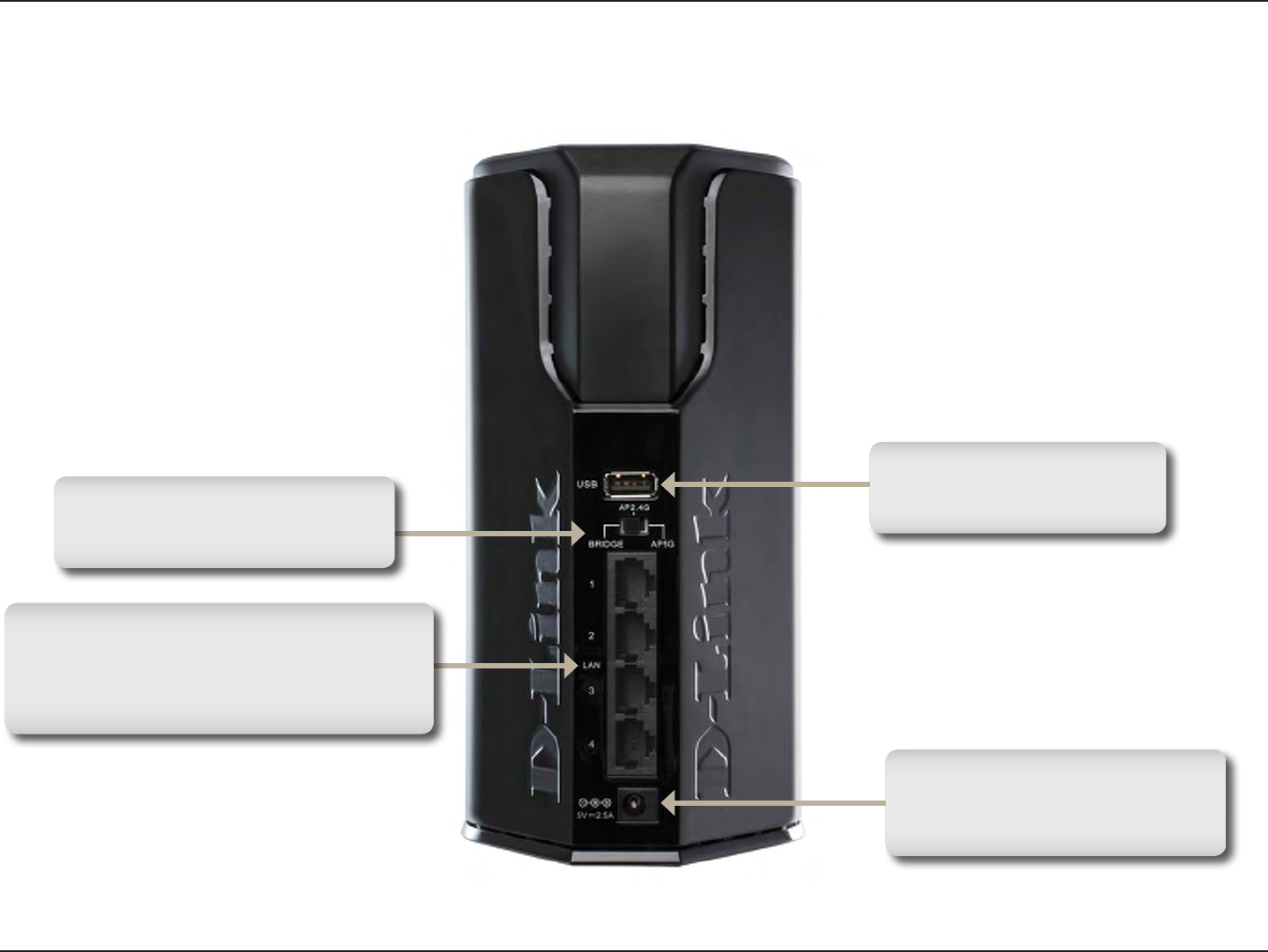
4D-Link DAP-1525 User Manual
Section 1 - Product Overview
Power Receptor
Receptor for the supplied power
adapter.
USB Port
Use to connect to USB 2.0
printer sharing application.
Hardware Overview
Back View
Ethernet Ports
In AP mode, the Ethernet port is used to
connect to your switch/router. In Client
mode, the Ethernet port is used to connect
your computer to a wireless network.
Mode Switch
Use to switch among 2.4GHz AP,
5GHz AP, and Bridge mode.
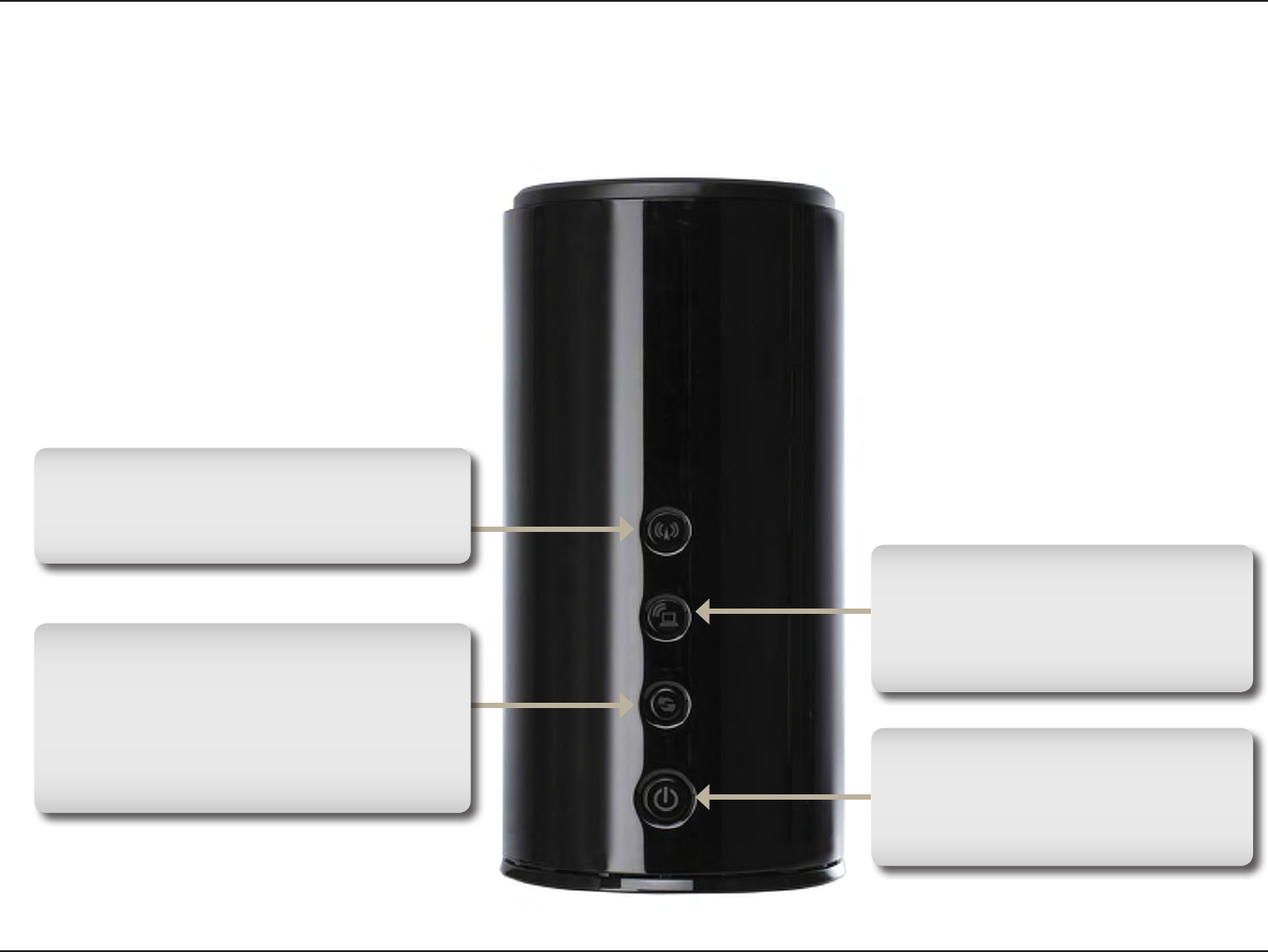
5D-Link DAP-1525 User Manual
Section 1 - Product Overview
Hardware Overview
Front View
Wireless LED (AP Mode)
A solid green light indicates the device is
ready to link.
WPS Button
Press the WPS button for 1 second to
initiate the WPS process. The button will
ash green while a WPS connection is being
established. The button will light green for
5 seconds if a successful WPS connection
has been made.
Wireless LED (Bridge Mode)
A solid green light indicates a link has
been established. A blinking green
indicates the device is fail to connect
to the AP.
Power LED
Press the button to power on the
device. The LED lights solid green to
indicate the power is on. Press the
button again to turn it off.

6D-Link DAP-1525 User Manual
Section 1 - Product Overview
Hardware Overview
Bottom View
Reset Button
Press the button to restore the
device to its original factory default
settings.

7D-Link DAP-1525 User Manual
Section 2 - Installation
This section will walk you through the installation process. Placement of the DAP-1525 is very important. Do not place
the Access Point in an enclosed area such as a closet, cabinet, or in the attic or garage.
Wireless Installation considerations
The D-Link wireless access point lets you access your network using a wireless connection from virtually anywhere
within the operating range of your wireless network. Keep in mind, however, that the number, thickness and location
of walls, ceilings, or other objects that the wireless signals must pass through, may limit the range. Typical ranges vary
depending on the types of materials and background RF (radio frequency) noise in your home or business. The key
to maximizing wireless range is to follow these basic guidelines:
1.KeepthenumberofwallsandceilingsbetweentheD-Linkaccesspointandothernetworkdevicestoaminimum.Each
wallorceilingcanreduceyouradapter’srangefrom3-90feet(1-30meters.)Positionyourdevicessothatthenumber
ofwallsorceilingsisminimized.
2.Be aware of the direct line between network devices.A wall that is 1.5 feet thick (0.5 meters), at a
45-degreeangleappearstobealmost3feet(1meter)thick.Ata2-degreeangleitlooksover42feet(14meters)thick!
Positiondevicessothatthesignalwilltravelstraightthroughawallorceiling(insteadofatanangle)forbetterreception.
3.BuildingMaterialsmakeadifference.Asolidmetaldoororaluminumstudsmayhaveanegativeeffectonrange.Tryto
positionaccesspoints,wirelessAccessPoints,andcomputerssothatthesignalpassesthroughdrywalloropendoorways.
Materialsandobjectssuchasglass,steel,metal,wallswithinsulation,water(shtanks),mirrors,lecabinets,brick,and
concretewilldegradeyourwirelesssignal.
4.Keepyourproductaway(atleast3-6feetor1-2meters)fromelectricaldevicesorappliancesthatgenerateRFnoise.
5.Ifyouareusing2.4GHz cordlessphonesorX-10(wirelessproductssuch asceilingfans,lights,andhomesecurity
systems),yourwirelessconnectionmaydegradedramaticallyordropcompletely.Makesureyour2.4GHzphonebase
isasfarawayfromyourwirelessdevicesaspossible.Thebasetransmitsasignalevenifthephoneinnotinuse.
Installation
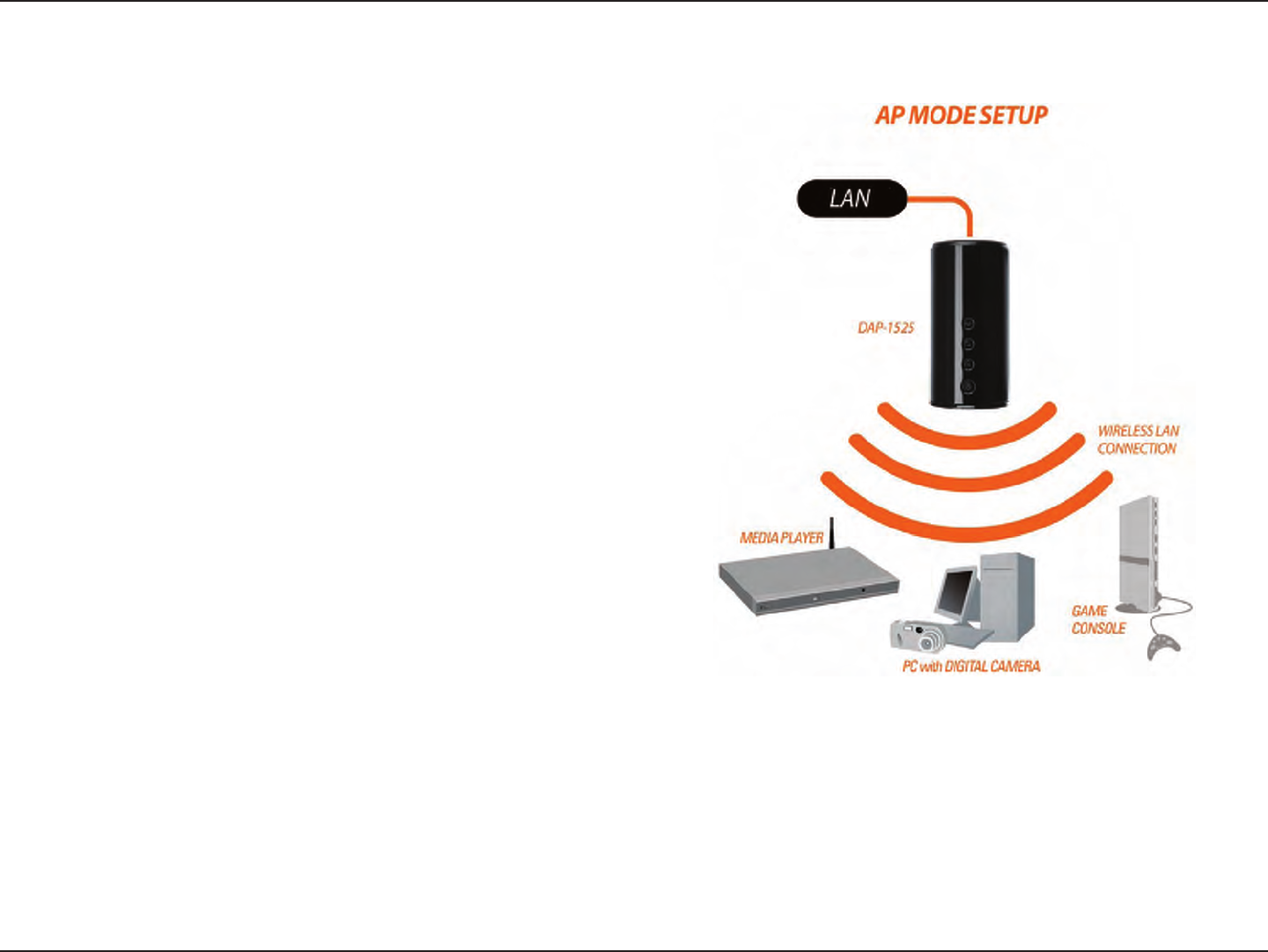
8D-Link DAP-1525 User Manual
Section 2 - Installation
Connection - AP Mode
To use the DAP-1525 in AP Mode, follow the steps below:
1. Ensure you have a broadband Internet connector,
such as a cable or DSL client line that connects the
Internet to your home or ofce.
2. Connect the cable properly or install the modem.
3. Connect the cable or modem with the broadband
Access Point.
4. Connect the DAP-1525’s Ethernet port to your LAN.
5. Move the switch to wireless 2.4GHz AP, or 5GHz AP
Mode.
6. Connect your PC or notebook to the DAP-1525 using
the PC or notebook’s wireless adapter.
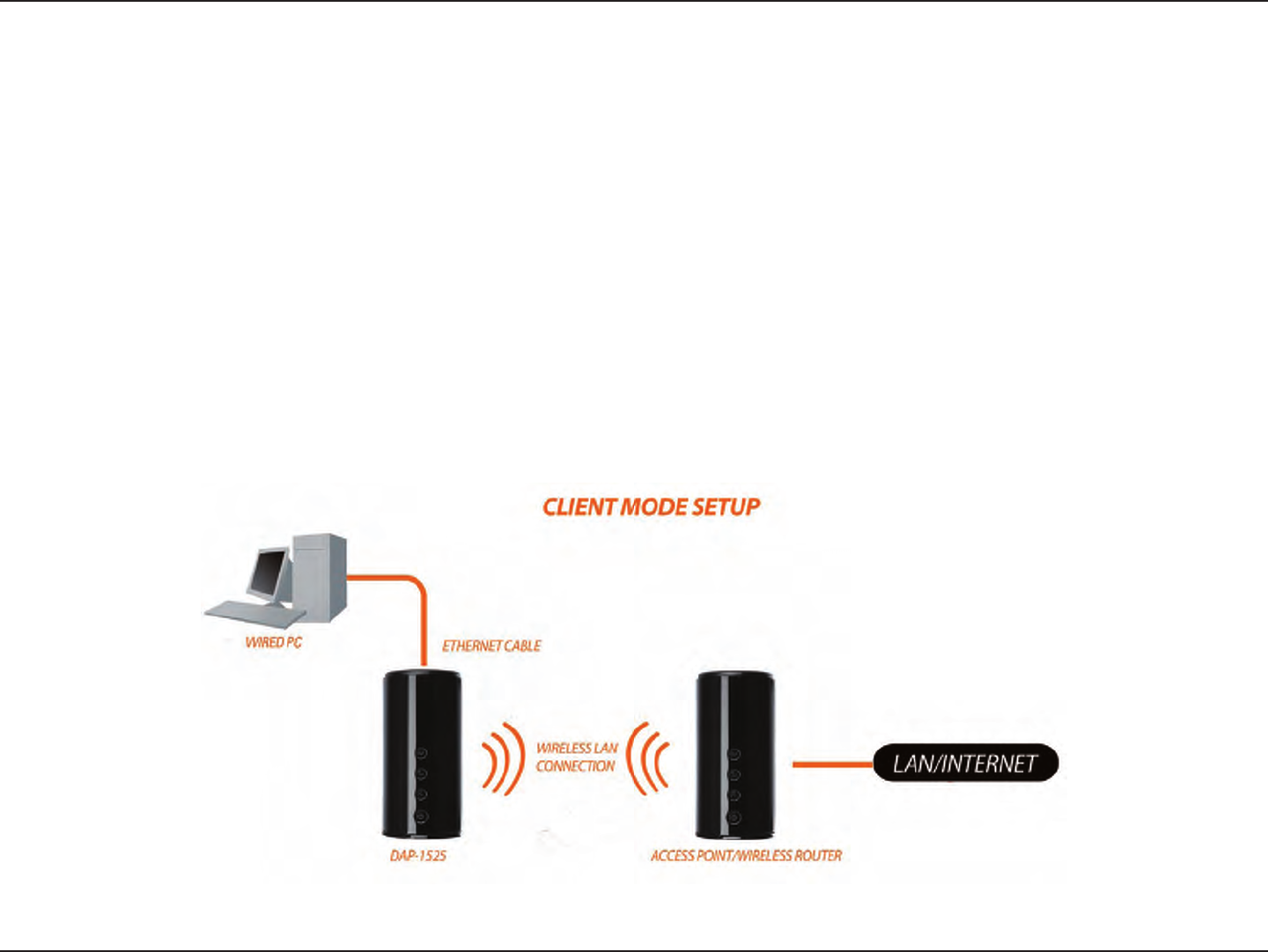
9D-Link DAP-1525 User Manual
Section 2 - Installation
Connection - Bridge Mode
To use the DAP-1525 in Bridge Mode, follow the steps below:
1. Ensure you have a broadband Internet connector, such as a cable or DSL client line that connects the Internet to
your home or ofce.
2. Connect the cable properly or install the modem.
3. Connect the cable or modem with the broadband Access Point.
4. Move the switch to Bridge Mode.
5. Connect your PC or notebook to the DAP-1525 using the PC or notebook’s wired adapter.

10D-Link DAP-1525 User Manual
Section 2 - Installation
One Touch AP Configuration
DAP-1525 supports One Touch AP Conguration. This feature makes DAP-1525 to have the ability to exchange or
learn the wireless prole from another wireless router or access point.
1. Press the WPS button on your existing router or access point. WPS LED will ash.
2. Press the WPS button on the DAP-1525 and hold it for 5 seconds to start One Touch AP Conguration.
3. When One Touch AP Conguration is complete, the DAP-1525 will have the same wireless settings as the existing
router or access point.
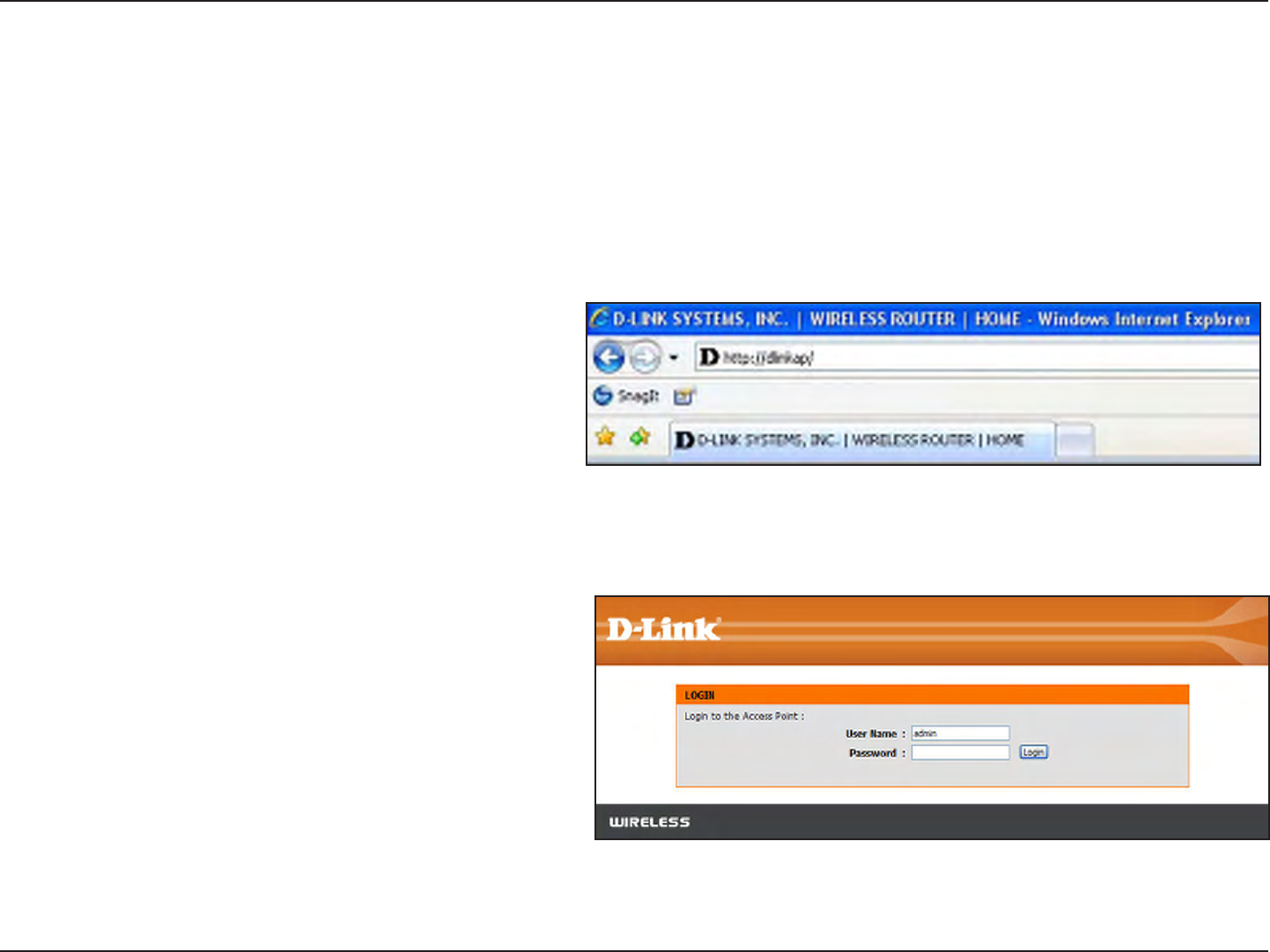
11D-Link DAP-1525 User Manual
Section 3 - Configuration
Configuration
This section will show you how to congure your new D-Link wireless Access Point using the Web-based conguration
utility.
Web-based Configuration Utility for AP Mode
To access the configuration utility, open a web
browser such as Internet Explorer and enter
http://dlinkap or http://192.168.0.50 in the address
eld.
Type Admin in the User Name eld and then enter
your password. Leave the password blank by default.
Click the Login button to log in to the Access Point.
If you get a Page Cannot be Displayed error, please
refer to the Troubleshooting section for assistance.

12D-Link DAP-1525 User Manual
Section 3 - Configuration
Setup Wizard
Click Launch Wireless Setup Wizard to quickly
congure your access point.
A welcome window appears. Click the Next button
to continue.

13D-Link DAP-1525 User Manual
Section 3 - Configuration
Click the WPS radio button if your wireless device
supports Wi-Fi Protected Setup. Click the Manual
radio button if you want to congure the network
manually. For Manual conguration, skip to page 15.
Click the Next button to continue.
Select PIN to enter the PIN number from other
wireless device to connect to your network.
For PBC conguration, skip to page 14.
Click Connect to continue.
Start WPS on the wireless device that you are adding
to your wireless network to complete the setup.
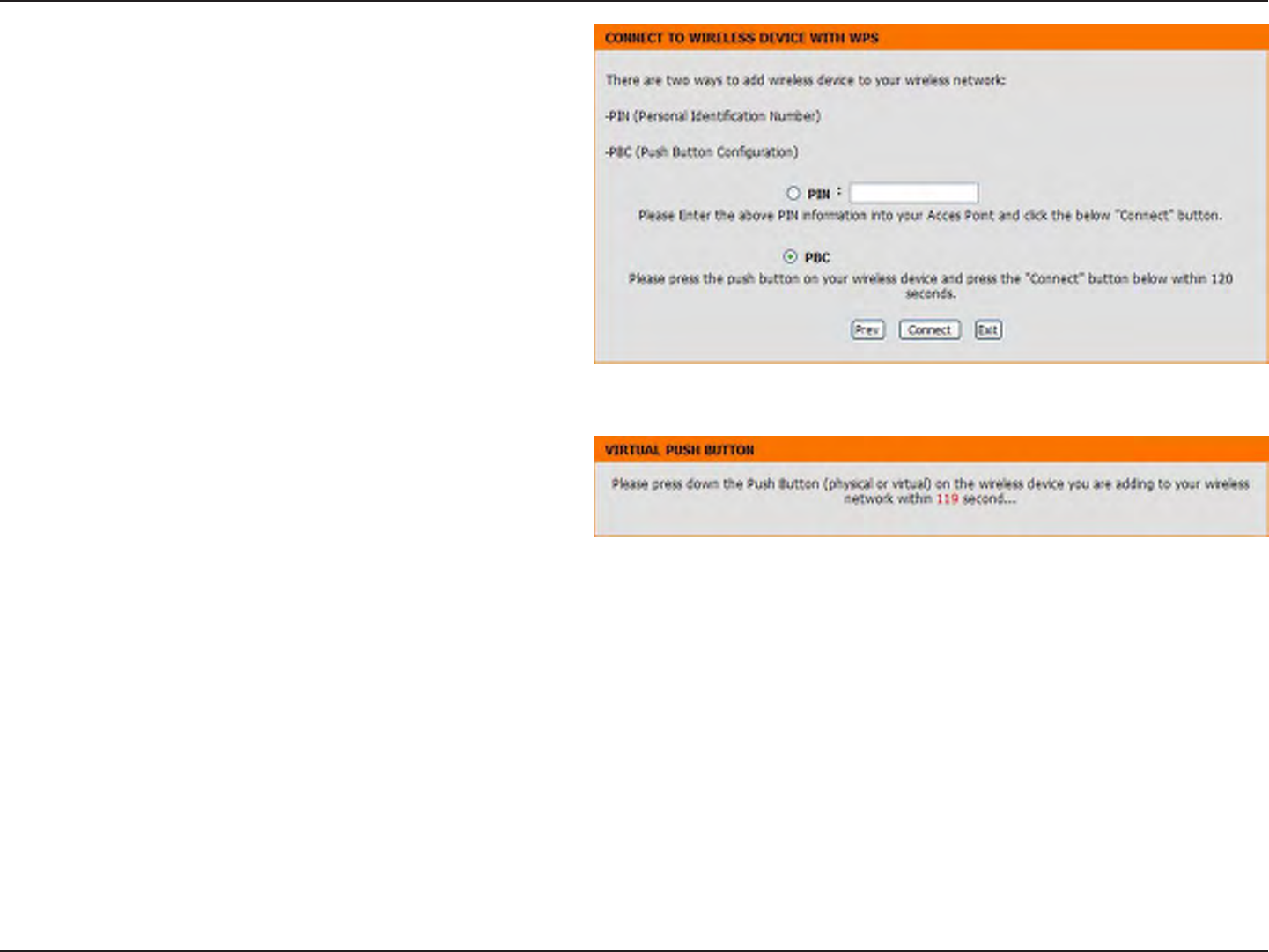
14D-Link DAP-1525 User Manual
Section 3 - Configuration
Select PBC to use the Push Button Conguration in
order to connect to your network.
Click Connect to continue.
Press the Push Button on the wireless device that
you are adding to your network to complete the
setup.

15D-Link DAP-1525 User Manual
Section 3 - Configuration
Select Manual as the conguration method to set
up your network manually.
Click Next to continue
Enter a network name (SSID). Tick the Assign a
network key check box to manually enter a WPA key
between 8 and 63 characters. Deselect the Assign
a network key check box to automatically assign a
network key.
Click Next to continue.
This window displays the settings.
Click the Save button to save the settings.
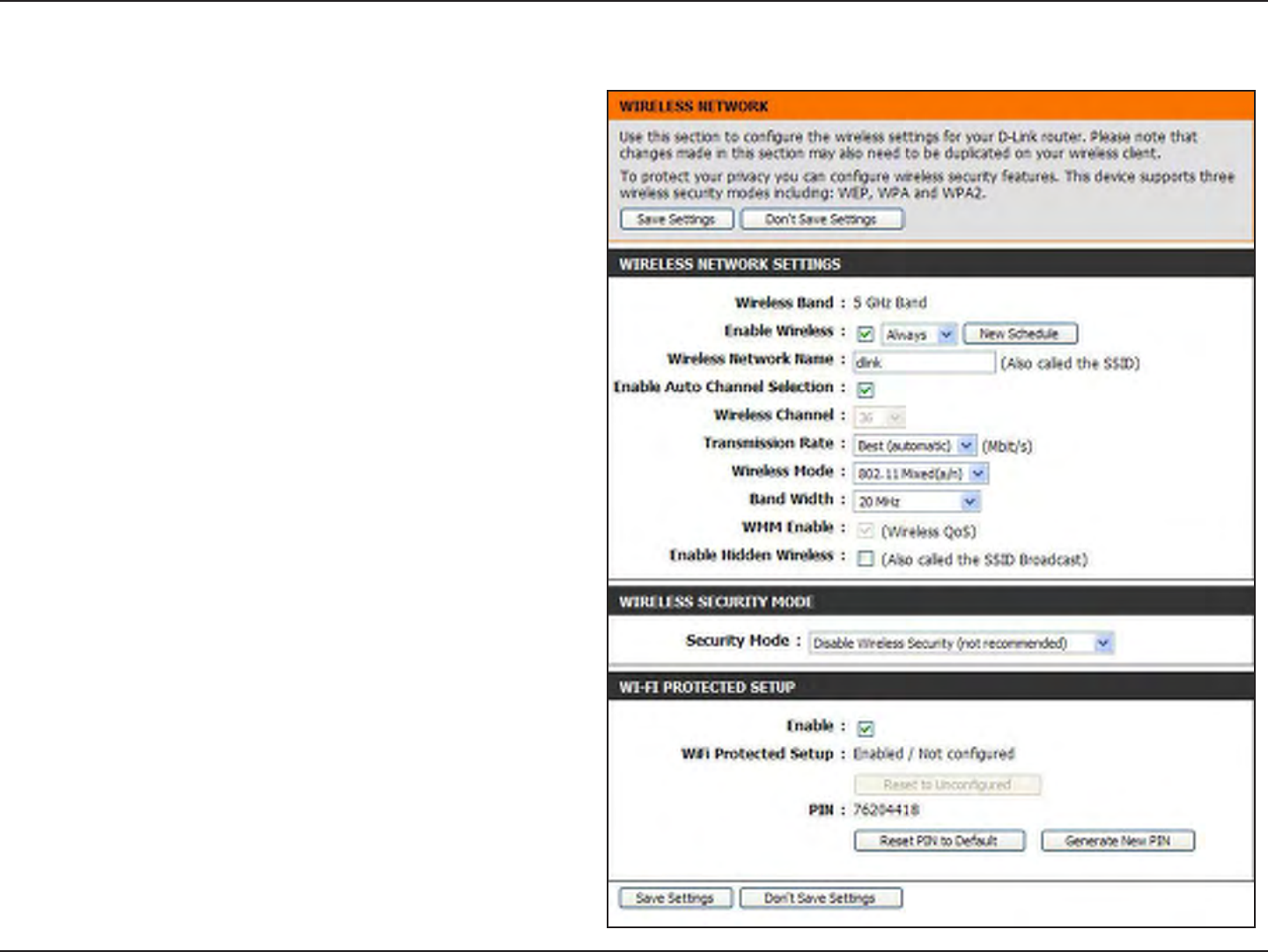
16D-Link DAP-1525 User Manual
Section 3 - Configuration
Wireless Settings
Tick the check box to enable the wireless
function. If you do not want to use wireless, de-
select the check box to disable all the wireless
functions. Use the drop-down menu to select
the time to enable the wireless function, or
click the New Schedule button to create a
new time period.
Service Set Identier (SSID) is the name of
your wireless network. Create a name using up
to 32 characters. The SSID is case-sensitive.
The Auto Channel Scan setting can be
selected to allow the DAP-1525 to choose the
channel with the least amount of interference.
Indicates the channel setting for the DAP-
1525. The Channel can be changed to t
the channel setting for an existing wireless
network or to customize the wireless network.
If you enable Auto Channel Scan, this option
will be grayed out.
Select the transmit rate. It is strongly
suggested to select Best (automatic) for
best performance.
Use the drop-down menu to select the wireless
mode among 802.11n only, 802.11 Mixed (b/g)
only and 802.11 Mixed (b/g/n) in 2.4GHz Band,
or 802.11a only, 802.11n only and 802.11
Mixed (a/n) in 5 GHz Band.
Enable
Wireless:
Wireless
Network Name:
Enable Auto
Channel
Selection:
Wireless
Channel:
Transmission
Rate:
Wireless Mode:

17D-Link DAP-1525 User Manual
Section 3 - Configuration
Use the drop-down menu to select the Operating frequency band.
WMM (Wi-Fi Multimedia) is QoS for your wireless network. Tick this box to improve the quality of video and voice applications
for your wireless clients. This feature is not available in 802.11n congurations.
Enabling Hidden Mode is another way to secure your network. With this option enabled, no wireless
clients will be able to see your wireless network when they perform a scan to see what’s available. In
order for your wireless devices to connect to your Access Point, you will need to manually enter the
Wireless Network Name on each device. This function is not available when WPS enabled.
Refer to Section 4 - Wireless Security for more information regarding wireless security.
Enable the Wi-Fi Protected Setup feature.
Bandwidth:
WMM Enable:
Enable Hidden
Wireless:
Security Mode:
Enable:
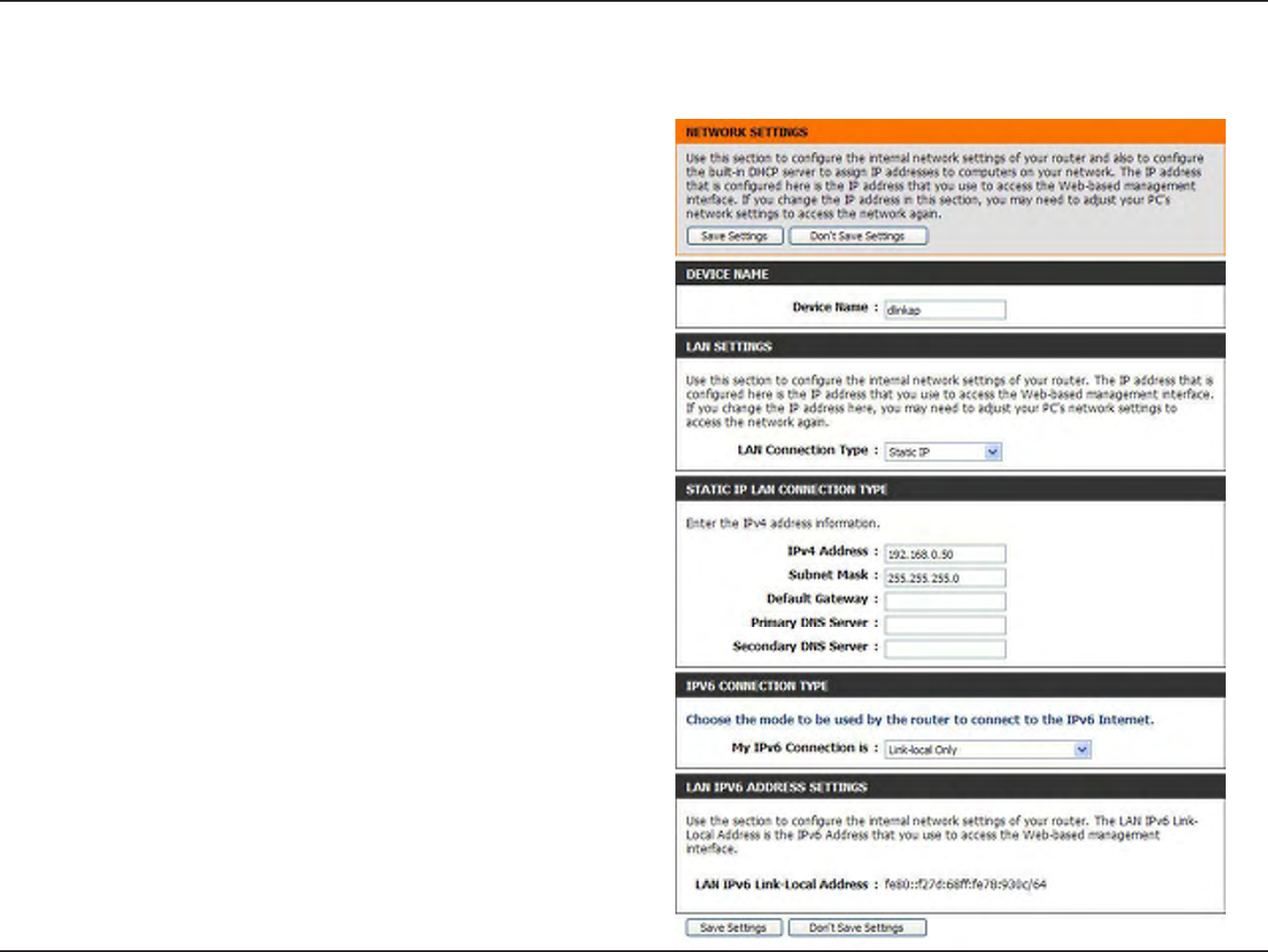
18D-Link DAP-1525 User Manual
Section 3 - Configuration
LAN Setup
This section will allow you to change the internal network settings of the Access Point and to congure the Static settings.
Enter the Device Name of the AP. It is recommended
to change the Device Name if there is more than
one D-Link device within the subnet.
Use the drop-down menu to select Static IP if
your ISP assigned you the IP address, subnet
mask, gateway, and DNS server addresses. Select
Dynamic IP (DHCP) to automatically assign an
IP address to the computers on the LAN/private
network.
Enter the IP address of the Access Point. The
default IP address is 192.168.0.50.
If you change the IP address, once you click Save
Settings, you will need to enter the new IP address
in your browser to get back into the conguration
utility.
Enter the subnet mask. The default subnet mask
is 255.255.255.0.
Enter the default gateway IP address.
Enter the primary DNS server IP address.
Enter the secondary DNS server IP address.
Use the drop-down menu to select the IPv6 mode
connected to the IPv6 Internet.
Device Name:
LAN Connection
type:
IPv4 Address:
Subnet Mask:
Default Gateway:
Primary DNS
Server:
Secondary DNS
Server:
My IPv6
Connection is:

19D-Link DAP-1525 User Manual
Section 3 - Configuration
LAN Setup
Static IPv6
Enter the staic IPv6 address provided by your
Internet Service Provider.
Enter the IPv6 subnet prex length.
Enter the default gateway IP address.
Enter the primary DNS server IP address.
Enter the secondary DNS server IP address.
IPv6 Address:
Subnet Prefix
Length:
Default Gateway:
Primary DNS
Server:
Secondary DNS
Server:
When using the My IPv6 Connection is drop-down menu to select the IPv6 mode, the LAN IPv6 Address Settings
section will vary based on the selected mode. Select Static IPv6 to see the following conguration.

20D-Link DAP-1525 User Manual
Section 3 - Configuration
LAN Setup
Auto-configuration
Click the raio button to directly obtain IPv6
DNS server automatically.
Click the raio button the enter IPv6 DNS
server manually.
Enter the primary DNS server IP address.
Enter the secondary DNS server IP address.
Obtain IPv6
DNS Servers
automatically:
Use the following
IPv6 DNS Servers:
Primary DNS Server:
Secondary DNS
Server:
When using the My IPv6 Connection is drop-down menu to select the IPv6 mode, the LAN IPv6 Address Settings
section will vary based on the selected mode. Select Autoconguration (Stateless/DHCPv6) to see the following
conguration.

21D-Link DAP-1525 User Manual
Section 3 - Configuration
When Turn MAC Filtering OFF is selected, MAC
addresses are not used to control network access.
When Turn MAC Filtering ON and ALLOW
computers listed to access the network is
selected, only computers with MAC addresses
listed in the MAC Address List are granted network
access. When Turn MAC Filtering ON and DENY
computers listed to access the network is
selected, any computer with a MAC address listed
in the MAC Address List is refused access to the
network.
Enter a description of the filtering rule in the
Description eld and enter the MAC address to
add the rule. Click the corresponding clear button
to delete the rule.
Configure MAC
Filtering below:
Rules:
MAC Address Filter
The MAC address lter section can be used to lter network access by machines based on the unique MAC addresses
of their network adapter(s). It is most useful to prevent unauthorized wireless devices from connecting to your network.
A MAC address is a unique ID assigned by the manufacturer of the network adapter.
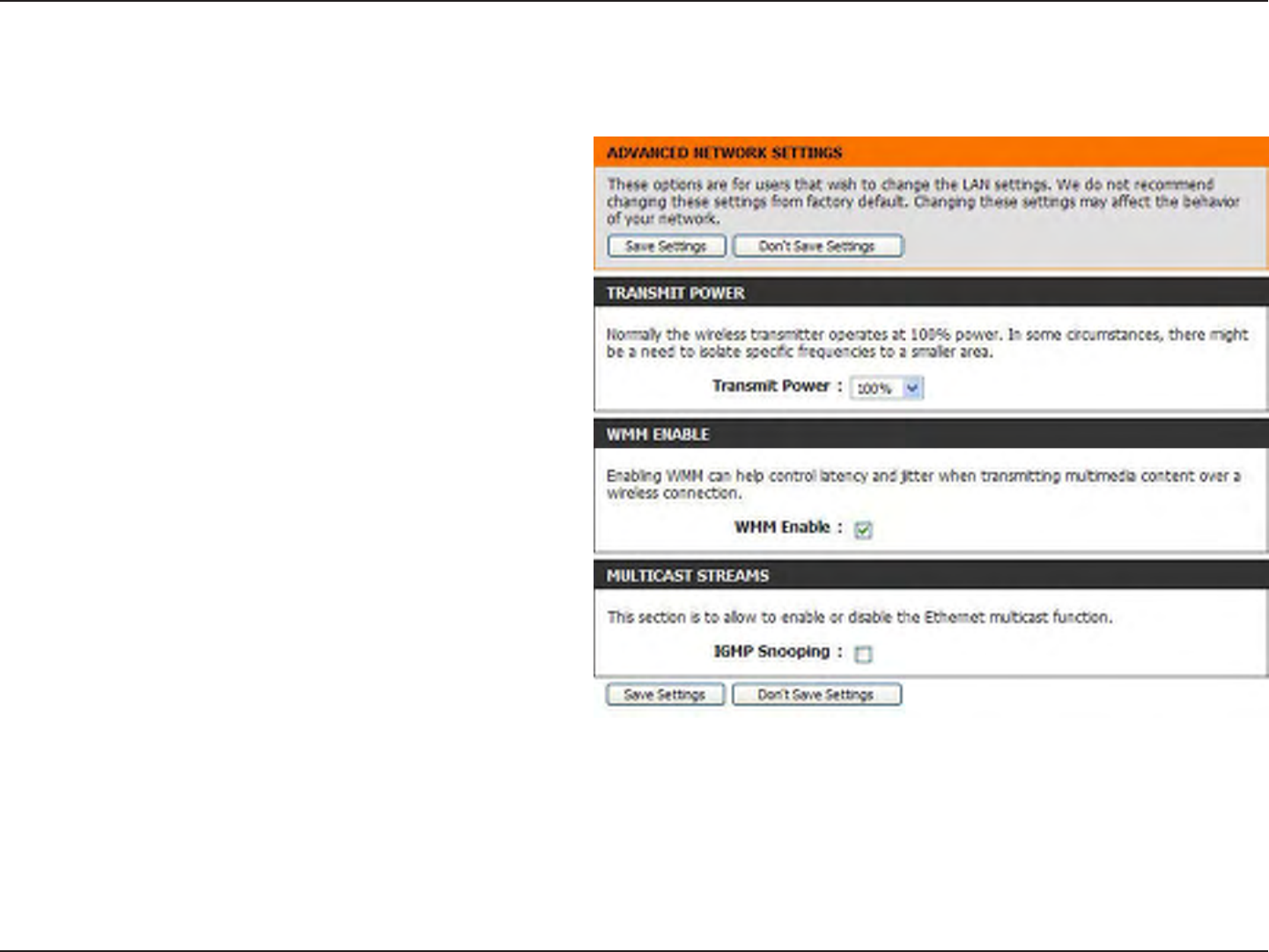
22D-Link DAP-1525 User Manual
Section 3 - Configuration
Advanced Network
User the drop-down menu to select the transmit
power of the antennas.
WMM is QoS for your wireless network. This will
improve the quality of video and voice applications
for your wireless clients.
This enables IGMP snooping for the wireless
connection. We recommend enabling this if
you often use multicast services such as video
conference and streaming audio/video.
Transmit Power:
WMM Enable:
IGMP Snooping:
This window is used to change the advanced LAN settings.
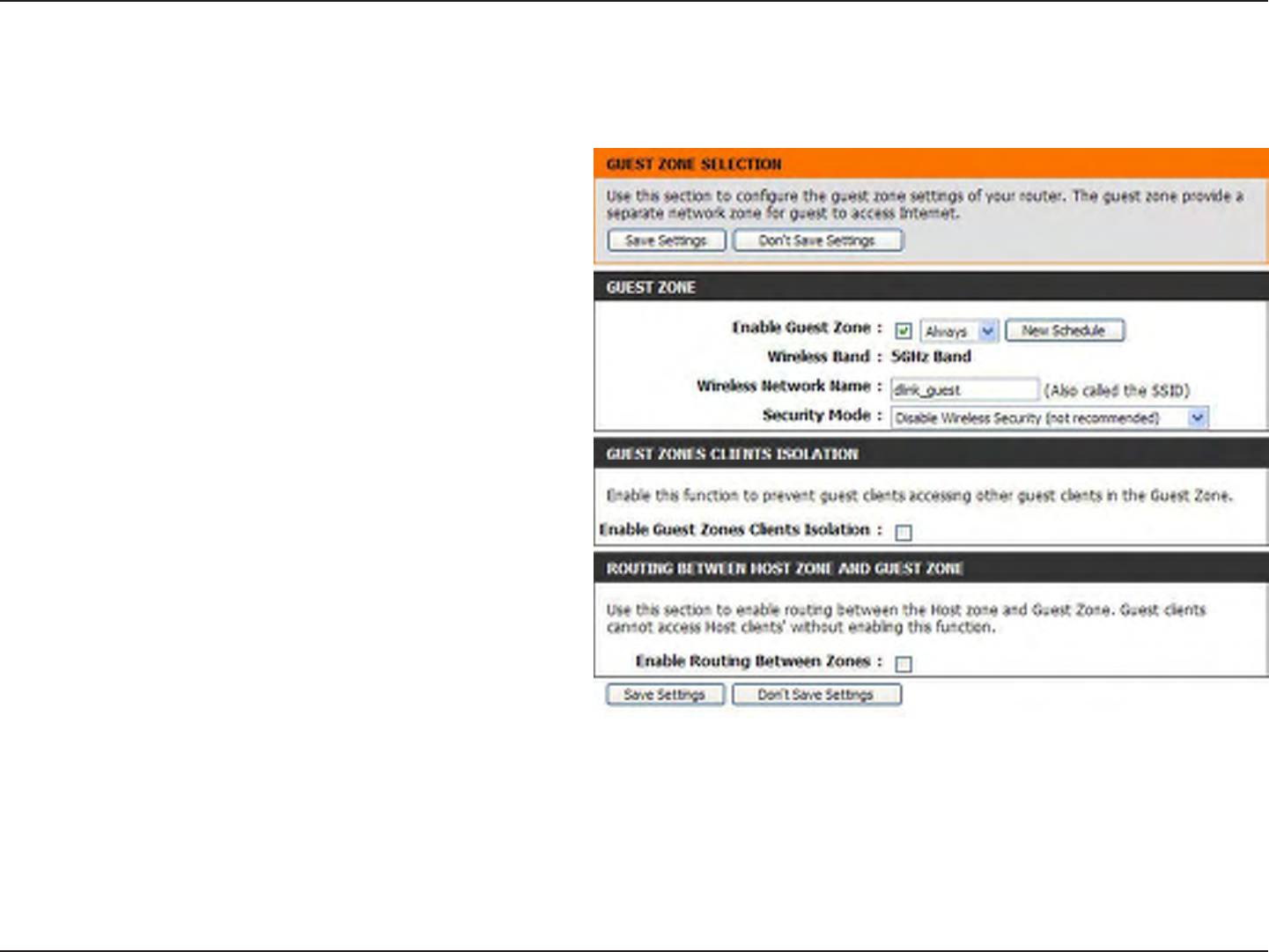
23D-Link DAP-1525 User Manual
Section 3 - Configuration
Guest Zone
Tick the check box to enable guest zone. Use the
drop-down menu to select the time for enabling
the function. Click New Schedule to congure the
schedule that can apply to this function.
Display the wireless band status.
Enter a name using up to 32 characters for the
wireless network. This is case-sensitive.
Refer to Section 4 - Wireless Security for more
information regarding wireless security.
Tick the check box to prevent the guest clients
from accessing other guests in the guest zone.
Tick the check box to enable routing between ths
host and guest zone.
Enable Guest
Zone:
Wireless Band:
Wireless
Network Name:
Security Mode:
Enable Guest
Zones Clients
Isolation:
Enable Routing
Between Zones:
The guest zone provide a separate network zone for guest to access the Internet.

24D-Link DAP-1525 User Manual
Section 3 - Configuration
Schedule
Enter a name for your new schedule.
Select a day, a range of days, or All Week to
include every day.
Check All Day - 24 hrs or enter a start and end
time for your schedule.
The list of schedules will be listed here. Click the
Edit icon to make changes or click the Delete icon
to remove the schedule.
Name:
Day(s):
Time:
Schedule Rules
List:
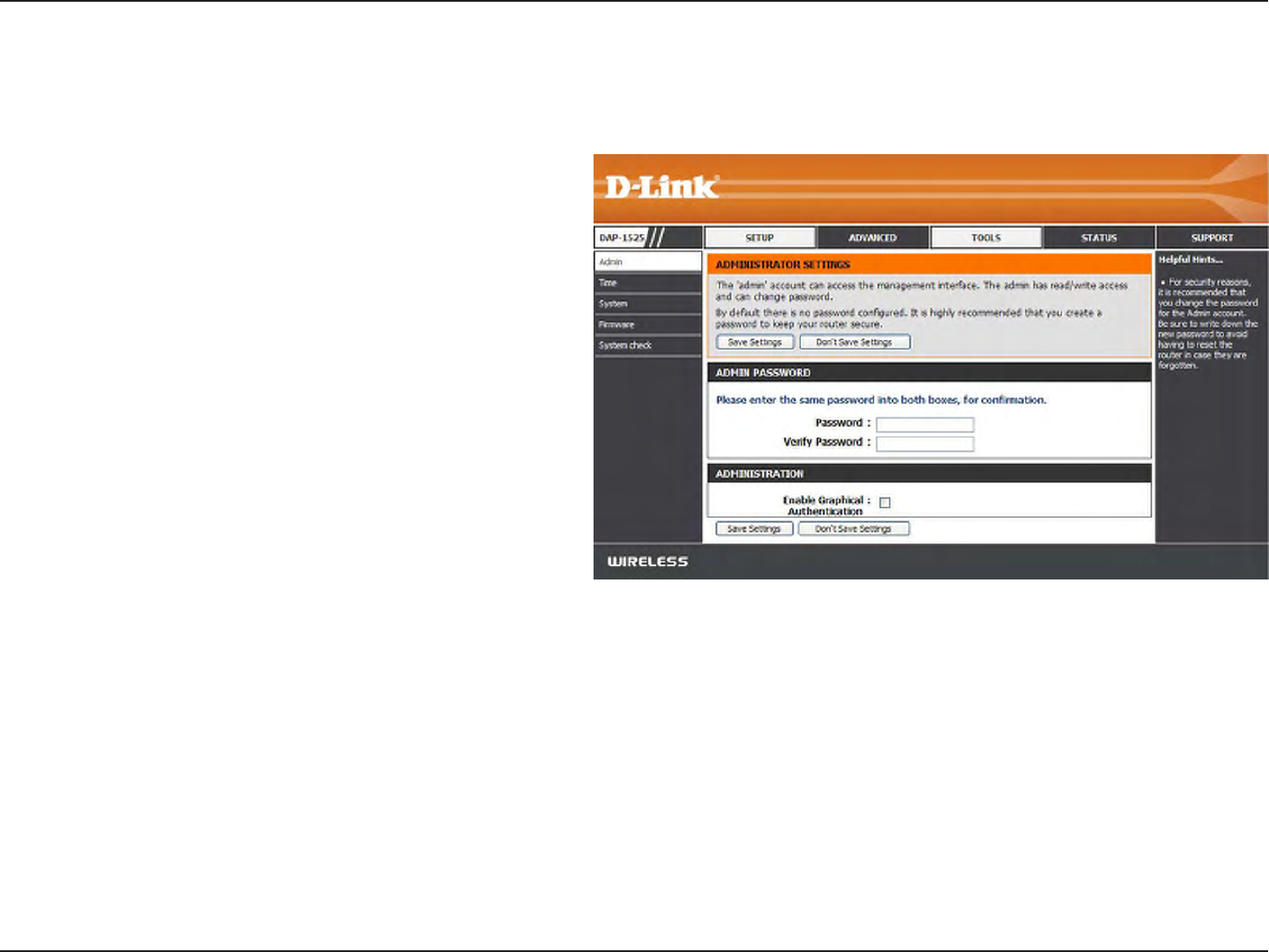
25D-Link DAP-1525 User Manual
Section 3 - Configuration
Admin
Enter a new password for the Administrator
Login Name. The administrator can make
changes to the settings.
Retype the new password for the Administrator
Login Name.
Tick the check box to enable Graphical
Authentication.
Password:
Verify
Password:
Enable Graphical
Authentication:
The “admin” account has the read and write access right. You can also enable Remote Management.
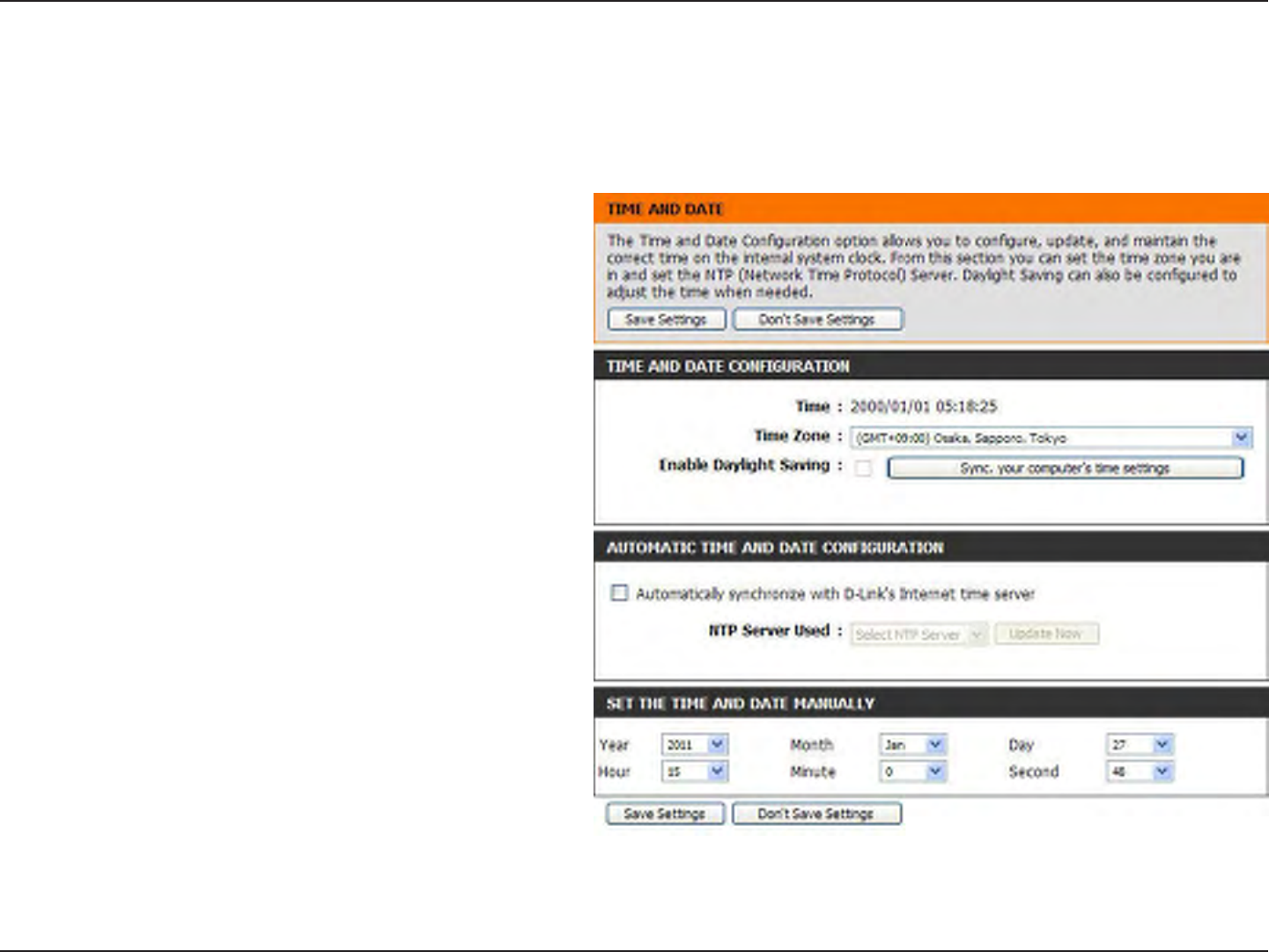
26D-Link DAP-1525 User Manual
Section 3 - Configuration
Time
Select the Time Zone from the drop-down menu.
Tick the check box to enable Daylight Saving
Time.
Click this button to set the device’s time the
same to local PC.
Tick the check box to enable the device to
automatically synchronize with a D-Link NTP
Server. NTP stands for Network Time Protocol.
NTP synchronizes computer clock times in a
network of computers. This will only connect
to a server on the Internet, not a local server.
Select one of the D-Link NTP Servers from
the drop-down menu. The DAP-1525 will then
synchronize its clock to be the same time as
the D-Link Internet
time server. Click the Update Now button to
synchronize with the D-Link Internet time server
immediatley.
To manually input the time, use the drop-down
menus to enter the values in these elds for the
Year, Month, Day, Hour, Minute, and Second.
Time Zone:
Enable
Daylight
Saving:
Sync your
computer’s time
settings:
Automatically
synchronize
with D-Link’s
Internet time
server:
NTP
Server Used:
Set the Time
and Date
Manually:
The Time Conguration option allows you to congure, update, and maintain the correct time on the internal system
clock. From this section you can set the time zone that you are in and set the Time Server. Daylight Saving can also
be congured to automatically adjust the time when needed.
Click the Save Settings button to save any changes made.
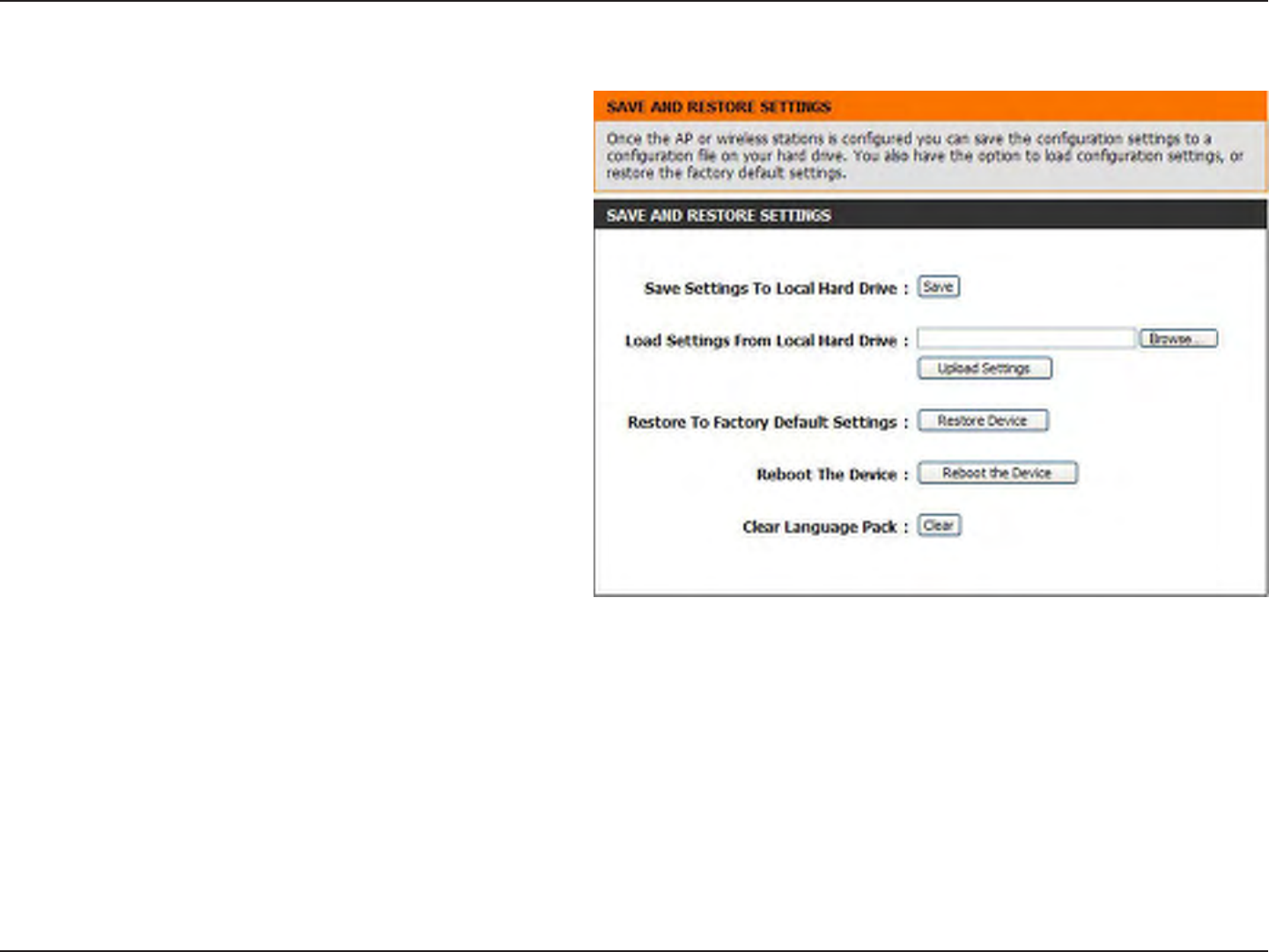
27D-Link DAP-1525 User Manual
Section 3 - Configuration
System
Use this option to save the current Access Point
conguration settings to a le on the hard disk
of the computer you are using. First, click the
Save button. You will then see a le dialog,
where you can select a location and le name
for the settings.
Use this option to load previously saved Access
Point configuration settings. First, use the
Browse control to nd a previously save le of
conguration settings. Then, click the Upload
Settings button to transfer those settings to the
Access Point.
Click the Restore Device button to restore all
conguration settings back to the settings that
were in effect at the time the Access Point was
shipped from the factory. Any settings that have
not been saved will be lost, including any rules
that you have created. If you want to save the
current Access Point conguration settings, use
the Save button above.
Click to reboot the access point.
Click the Clear button to restore the device back
to the English interface version and remove
other languages installed for the system web
pages.
Save Settings
To Local Hard
Drive:
Load Settings
From Local
Hard Drive:
Restore To
Factory
Default
Settings:
Reboot The
Device:
Clear
Language
Pack:

28D-Link DAP-1525 User Manual
Section 3 - Configuration
Firmware
Displays the current rmware version.
Displays the current rmware date.
After you have downloaded the new rmware,
click the Browse control to locate the rmware
update on your hard drive. Click Upload to
complete the rmware upgrade.
This function allows the user to transfer the
language of web user interface from English to
their own language by upgrading the language
pack. Click the Browse button to locate the
desired language pack on your hard drive.
Click Upload to complete the language pack
upgrade.
Current
Firmware
Version:
Current
Firmware
Date:
Firmware
Upgrade:
Language
Pack
Upgrade:
You can upgrade the rmware of the access point here. Please check the D-Link support site for rmware updates at
http://support.dlink.com or simply click the Check Now button located in the Firmware Information section. You can
download rmware upgrades to your hard drive from the D-Link support site. Make sure the rmware you want to use
is on the local hard drive of the computer. Click on Browse to locate the rmware le to be used for the update.
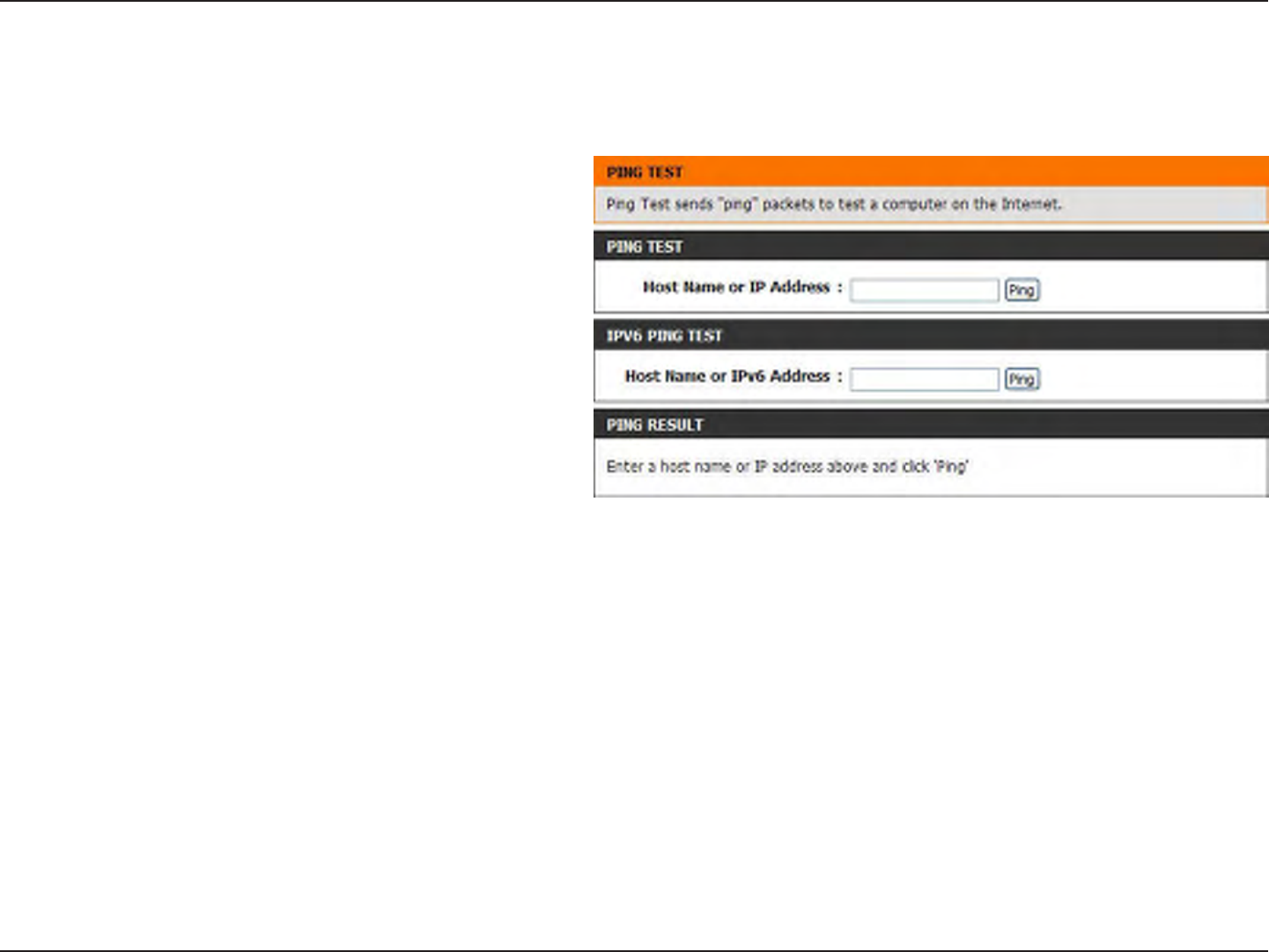
29D-Link DAP-1525 User Manual
Section 3 - Configuration
System Check
The Ping Test / IPv6 Ping Test is used to
send Ping packets to test if a computer is on
the Internet. Enter the host name or IP/IPv6
address that you wish to Ping, and click Ping.
The results of your ping attempts will be
displayed here.
Ping Test /
IPv6 Ping Test:
Ping Result:
The System Check feature allows you to verify the physical connectivity on both the LAN and Internet interface.
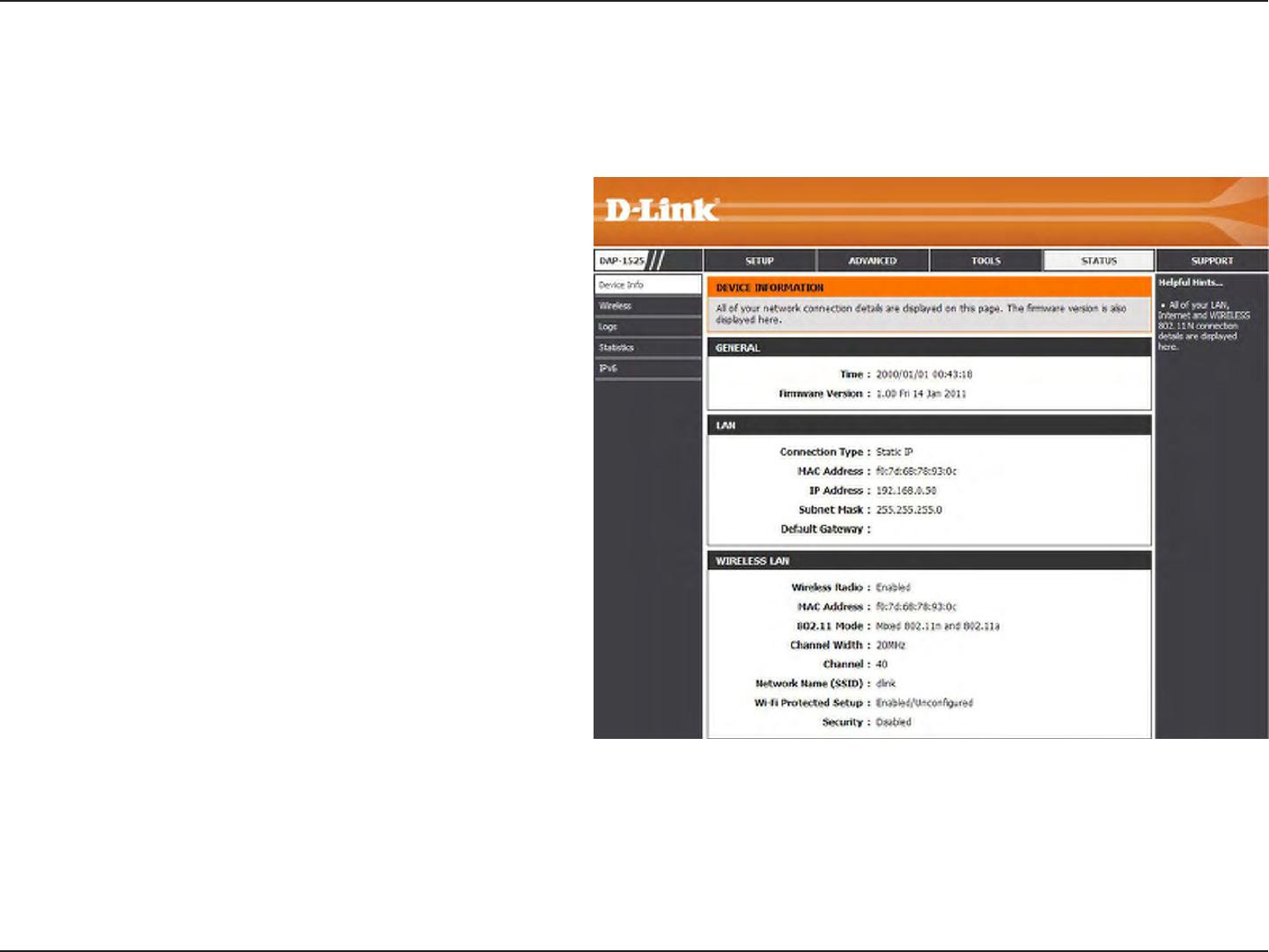
30D-Link DAP-1525 User Manual
Section 3 - Configuration
Device Info
This page displays the current information for the DAP-1525. It will display the LAN and Wireless information, in addition
to the rmware version and date the rmware was last updated.
General:
LAN:
Wireless
LAN:
Displays the access point’s time and rmware
version.
Displays the MAC address and the private
(local) IP settings for the access point.
Displays the wireless MAC address and your
wireless settings such as SSID and Channel.

31D-Link DAP-1525 User Manual
Section 3 - Configuration
Wireless
SSID:
MAC Address:
Uptime:
Mode:
RSSI:
Displays the wireless network name.
The Ethernet ID (MAC address) of the wireless
client.
Displays the amount of time the wireless client
has been connected to the access point.
The transmission standard being used by the
client. Values are 11a, 11b, 11g, 11ng or 11na
for 802.11a, 802.11b, 802.11g or 802.11n
respectively.
This is a relative measure of signal quality.
The value is expressed as a percentage of
theoretical best quality. Signal quality can be
reduced by distance, by interference from other
radio-frequency sources (such as cordless
telephones or neighboring wireless networks),
and by obstacles between the access point and
the wireless device.
The wireless section allows you to view the wireless clients that are connected to your wireless access point.

32D-Link DAP-1525 User Manual
Section 3 - Configuration
Logs
Save Log File To
Local Hard Drive:
Log Type & Level:
Log Files:
Click the Save button to save the access point
to a log le on your computer.
Use the radio buttons to select Log type and
level.
Displays log events. Click the Clear button to
delete all the records.
The access point automatically logs (records) events of possible interest in its internal memory. If there isn’t enough
internal memory for all events, logs of older events are deleted, but logs of the latest events are retained. The Logs
option allows you to view the access point logs. You can dene what types of events you want to view and the level
of the events to view. This access point also has external Syslog Server support so you can send the log les to a
computer on your network that is running a Syslog utility.

33D-Link DAP-1525 User Manual
Section 3 - Configuration
Statistics
The Statistics page displays all of the LAN and Wireless packets transmit and receive statistics.
TX Packet
Numbers:
RX Packet
Numbers:
TX Packets
Dropped:
RX Packets
Dropped:
TX Packets Bytes:
RX Packets Bytes:
The total number of packets sent from the
access point.
The total number of packets received by the
access point.
Displays the number of packets that were
dropped while sending, due to errors, collisions,
or access point resource limitations.
Displays the number of packets that were
droppedwhilereceiving,duetoerrors,collisions,
oraccesspointresourcelimitations.
Displays the number of bytes that were sent
fromtheaccesspoint.
Displaysthenumberofbytesthatwerereceived
bytheaccesspoint.
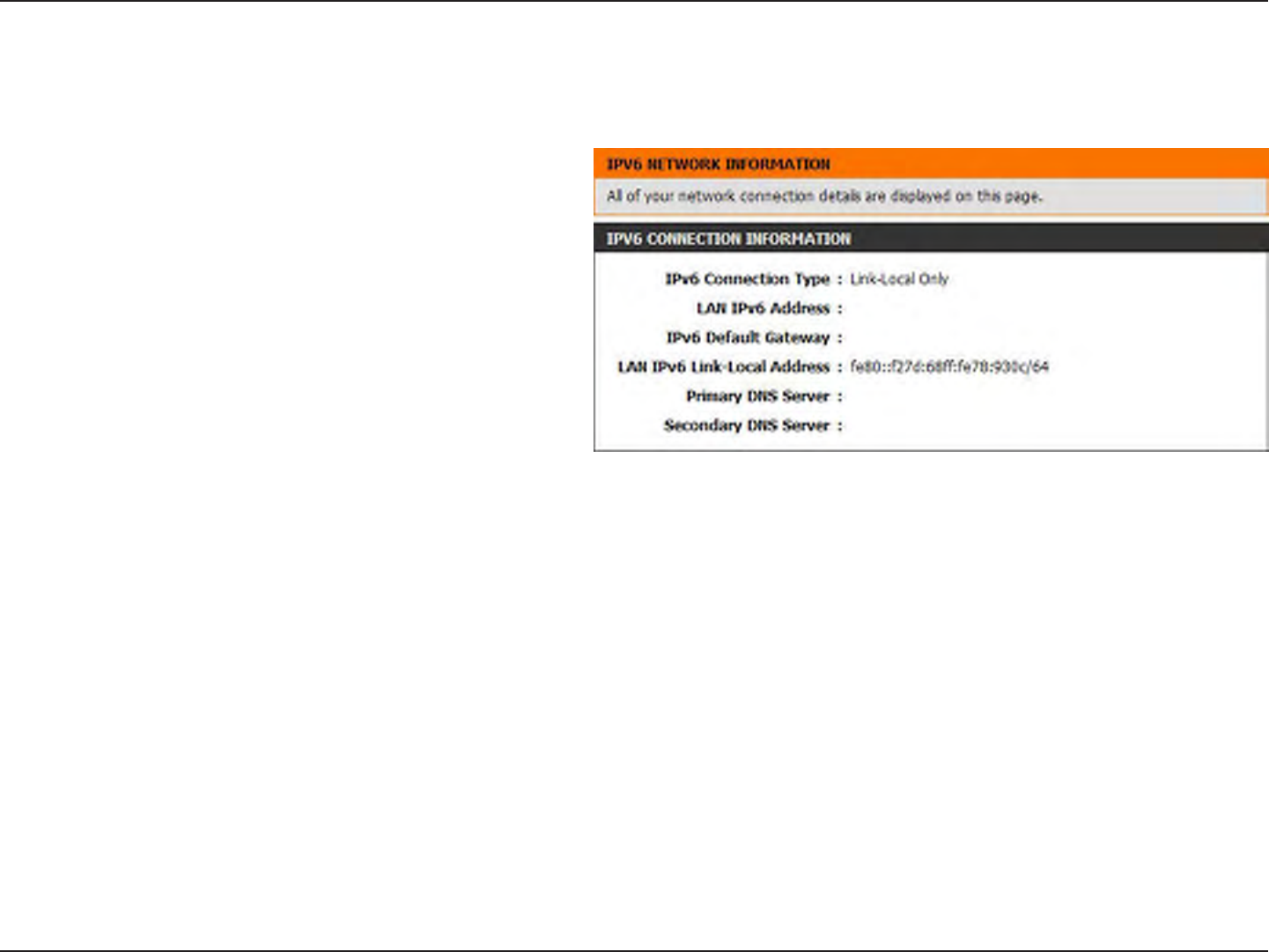
34D-Link DAP-1525 User Manual
Section 3 - Configuration
IPv6
The IPv6 page displays the detailed IPv6 network connection.
IPv6 Connection
Type:
LAN IPv6 Address:
IPv6 Default
Gateway:
LAN IPv6 Link-
Local Address:
Primary DNS
Server:
Secondary DNS
Server:
Displays IPv6 connection type.
Displays LAN IPv6 address.
Displays the IPv6 address of the default
gateway.
DisplaystheLANIPv6link-localaddress.
DisplaystheIPv6addressoftheprimaryDNS
server.
Displays the IPv6 address of the secondary
DNSserver.

35D-Link DAP-1525 User Manual
Section 3 - Configuration
Support
This page provides all the helpful support information of the Access Point.
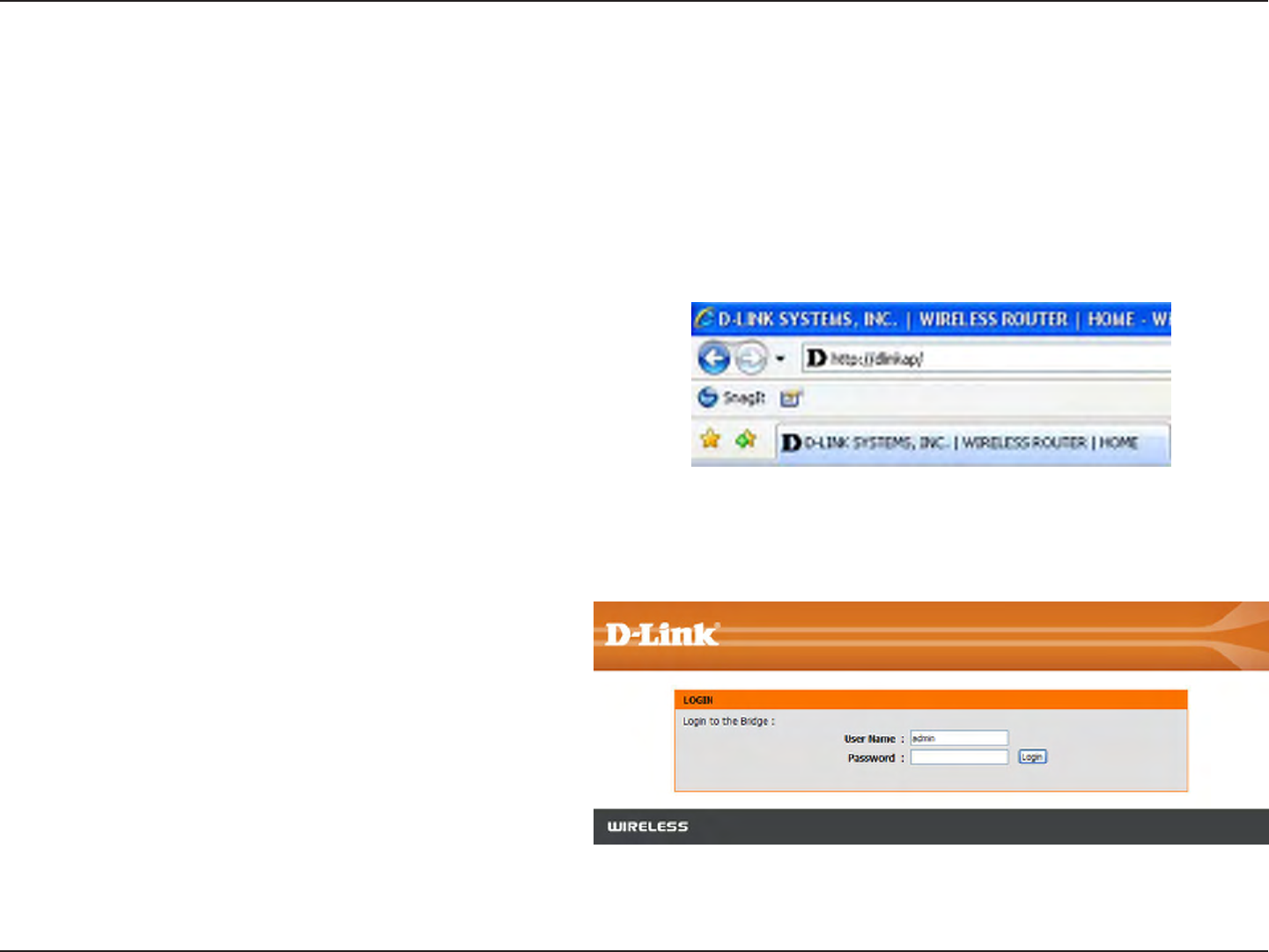
36D-Link DAP-1525 User Manual
Section 3 - Configuration
Configuration
This section will show you how to congure your new D-Link wireless Access Point using the Web-based conguration
utility.
Web-based Configuration Utility for Bridge Mode
To access the configuration utility, open a web
browser such as Internet Explorer and enter
http://dlinkap or http://192.168.0.50 in the address
eld.
Type Admin in the User Name eld and then enter
your password. Leave the password blank by default.
Click the Login button to log in to the Access Point.
If you get a Page Cannot be Displayed error, please
refer to the Troubleshooting section for assistance.
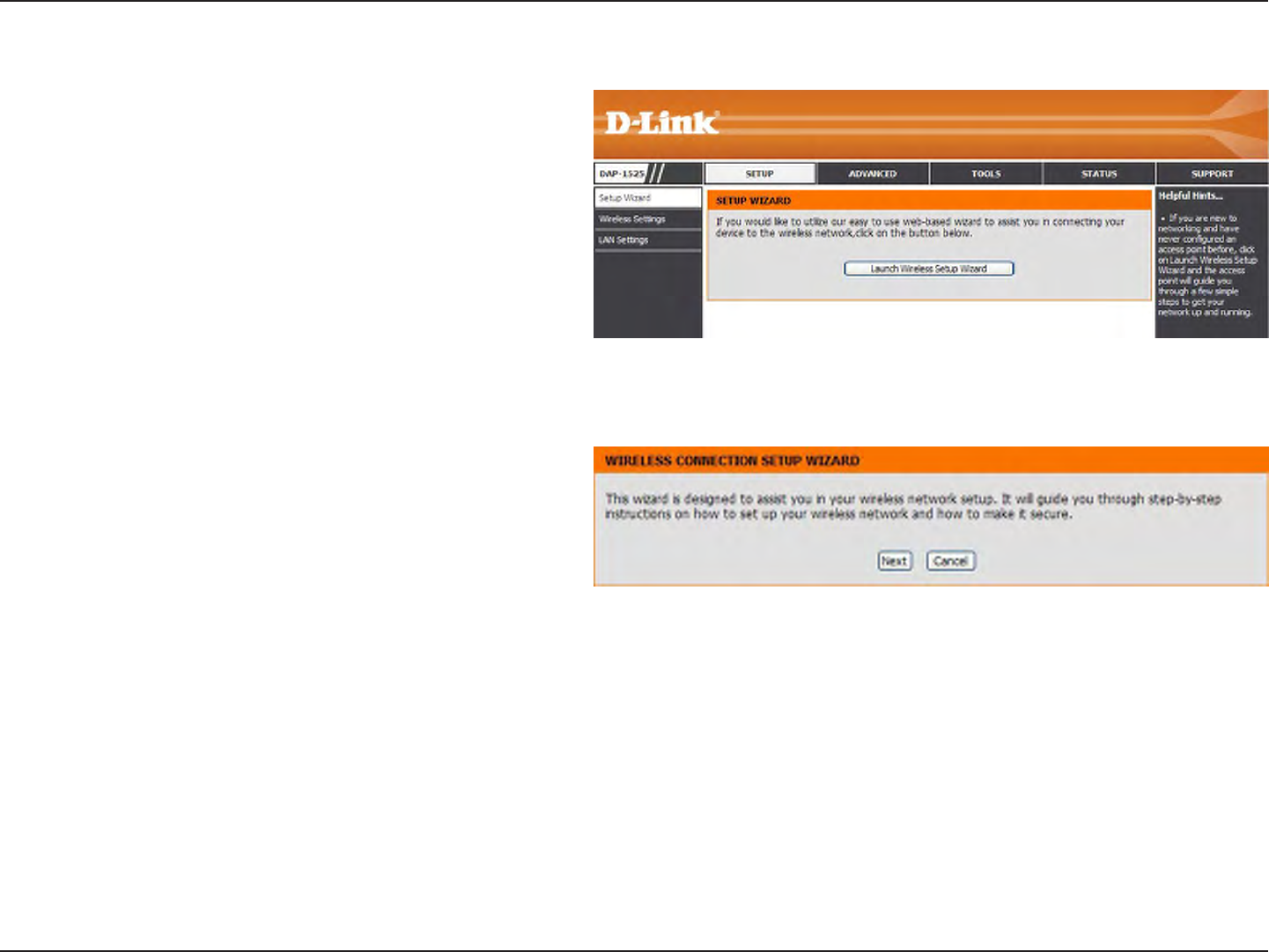
37D-Link DAP-1525 User Manual
Section 3 - Configuration
Setup Wizard
Click Launch Wireless Setup Wizard to quickly
congure your access point.
A welcome window appears. Click the Next button
to continue.
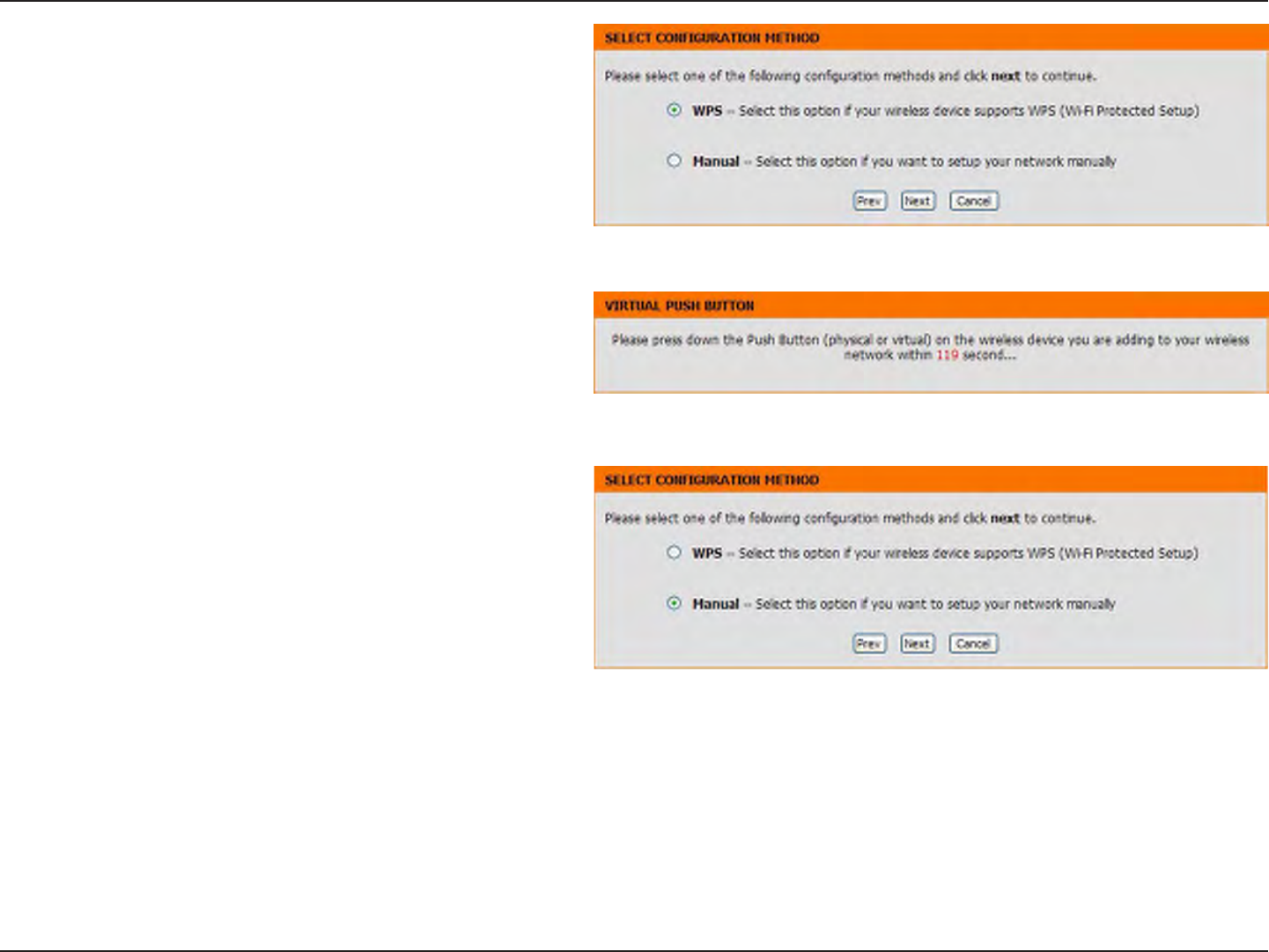
38D-Link DAP-1525 User Manual
Section 3 - Configuration
Click the WPS radio button if your wireless device
supports Wi-Fi Protected Setup. Click the Manual
radio button if you want to congure the network
manually. For Manual conguration, skip to page 38.
Click the Next button to continue.
Press the Push Button on the wireless device that
you are adding to your network to complete the
setup.
Select Manual as the conguration method to set
up your network manually.
Click Next to continue
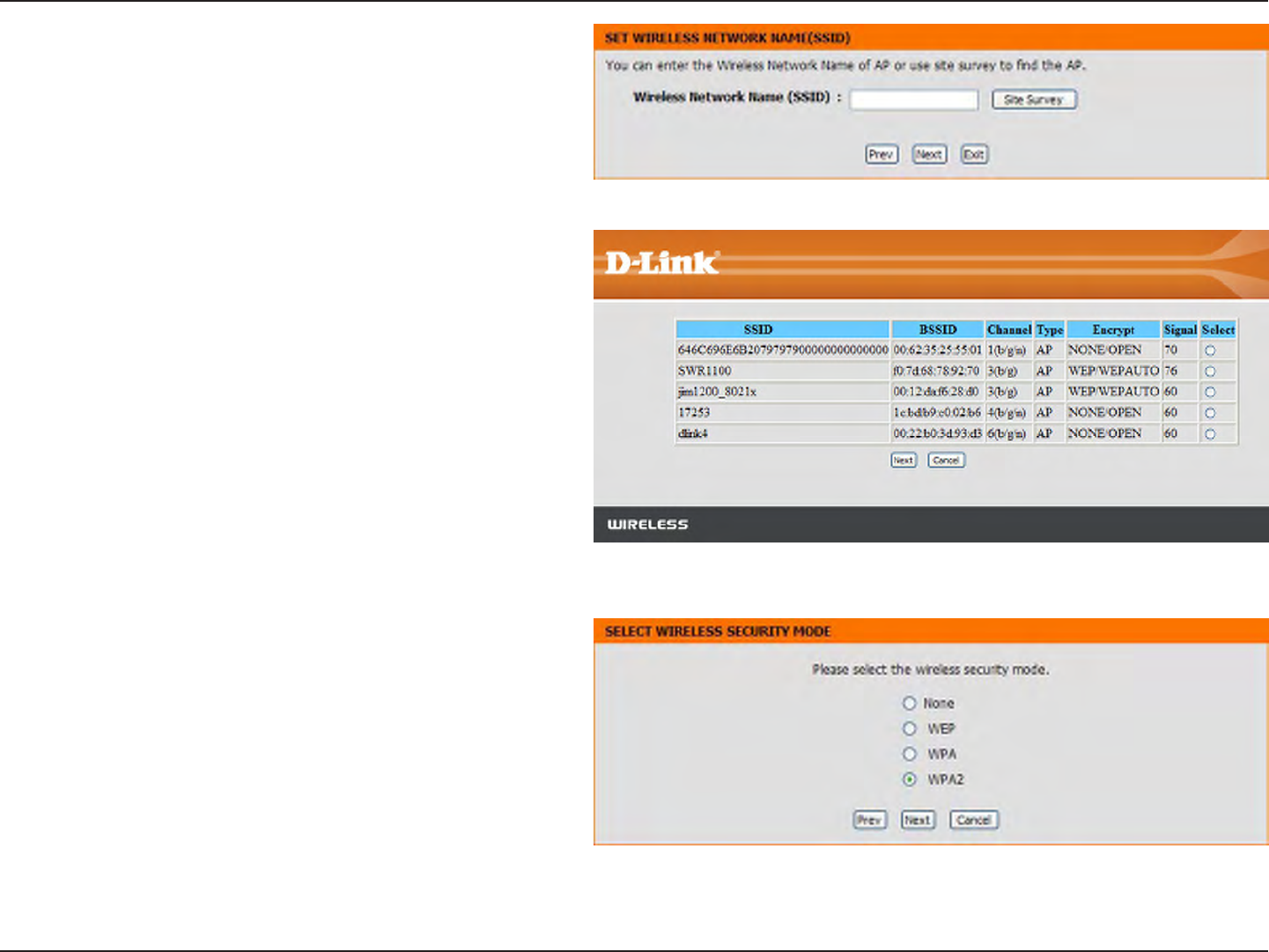
39D-Link DAP-1525 User Manual
Section 3 - Configuration
Enter the Wireless Network Name (SSID) of the
AP or click the Site Survey button to nd the AP.
Click Next to continue.
If clicking Site Survey, the following screen will be
displayed.
Find your access point from the list and click Next
to complete the Setup Wizard.
Choose which Security Mode you want to use and
click Next to continue.

40D-Link DAP-1525 User Manual
Section 3 - Configuration
If you choose WEP, enter the wireless security
password and click Next to complete the Setup
Wizard.
If you choose WPA or WPA2, enter the WPA/WPA2
Personal Passphrase and click Next to complete
the Setup Wizard.
The following screen opens to indicate that you have
successfully saved your new settings.
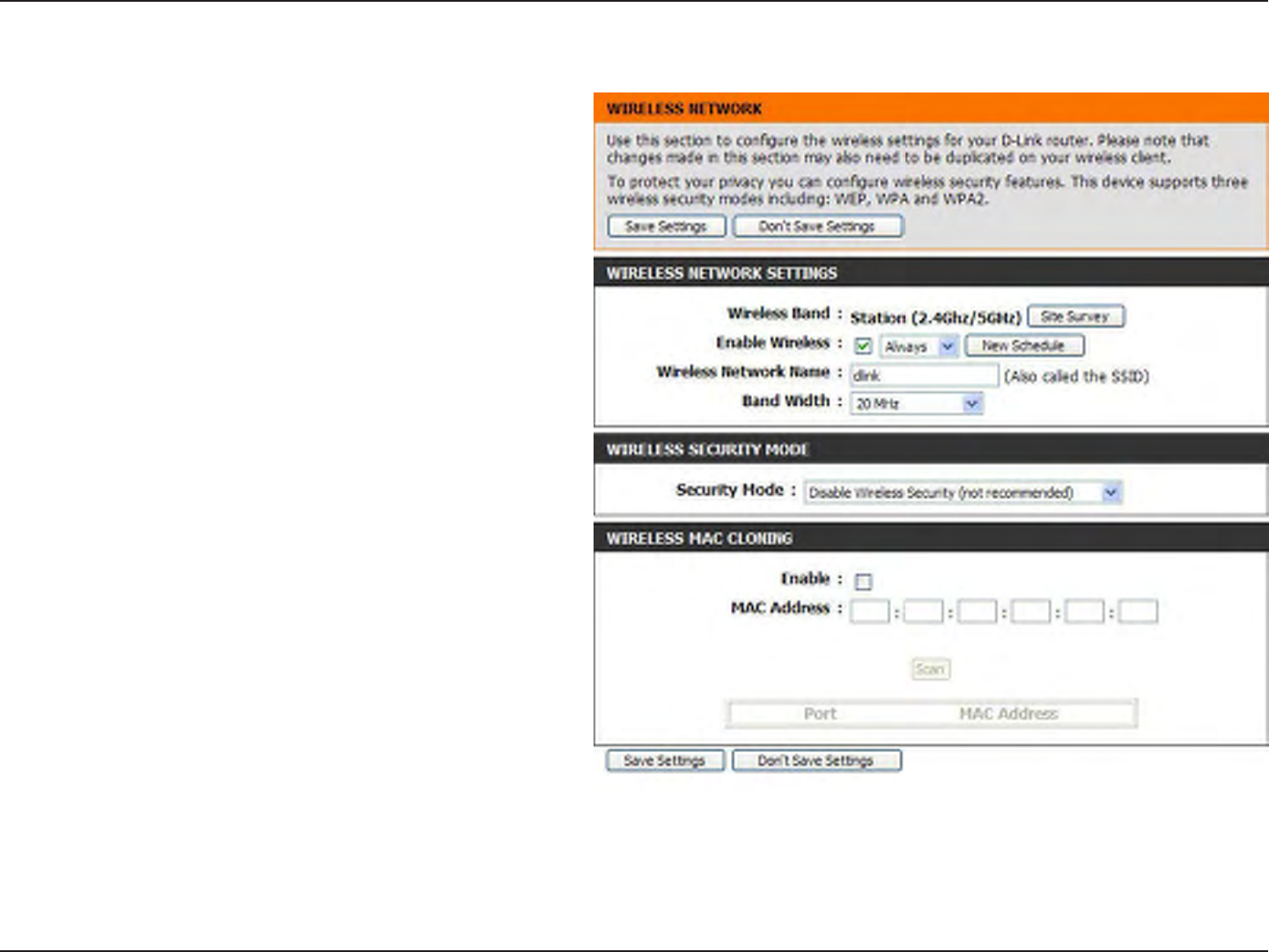
41D-Link DAP-1525 User Manual
Section 3 - Configuration
Wireless Settings
Tick the check box to enable the wireless
function. If you do not want to use wireless, de-
select the check box to disable all the wireless
functions. Use the drop-down menu to select
the time to enable the wireless function, or
click the New Schedule button to create a
new time period.
Enter the Wireless Network Name (SSID) of
the AP, or click the Site Survey button to nd
the AP.
Select the Band Width:
20/40 MHz (Auto) - Select if you are using both
802.11n and non-802.11n wireless devices.
20MHz - Select if you are not using any
802.11n wireless clients.
Refer to Section 4 - Wireless Security for
more information regarding wireless security.
Enable
Wireless:
Wireless
Network Name:
Band Width:
Security Mode:
Wireless Mac Cloning
Enabling this option allows the user to manually assign
the source MAC address to packets forwarded by
the DAP-1525. If not manually assigned, the packet’s
source MAC address field will be automatically
selected as the DAP-1525’s MAC address.
Enter the desired MAC address connected to your DAP-1525 to enable the clone function.
ClicktheScanbuttontosearchforallavailabledevicesconnectedtoyourDAP-1525’sEthernetports.
MAC Address:
Scan:
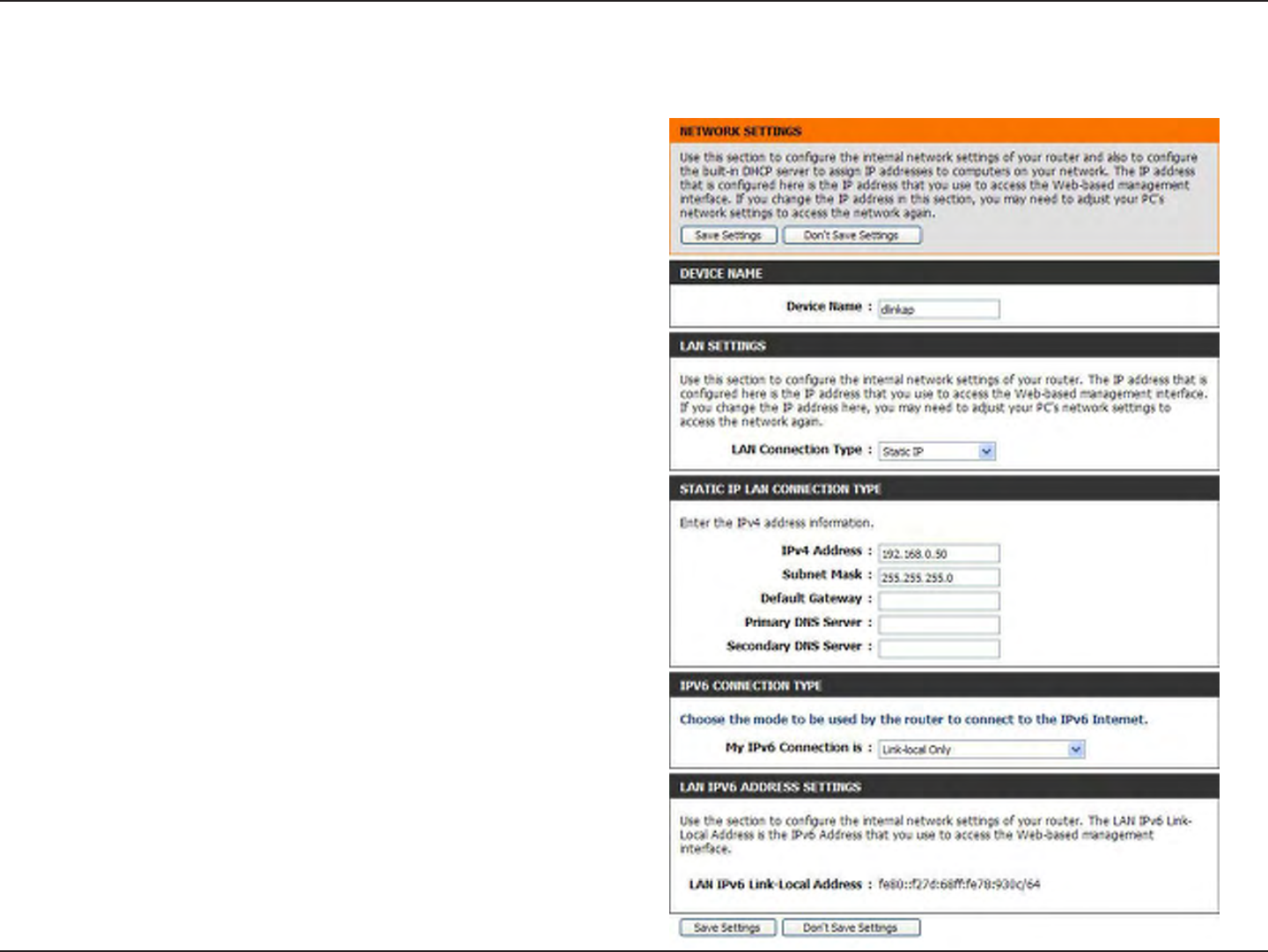
42D-Link DAP-1525 User Manual
Section 3 - Configuration
LAN Setup
This section will allow you to change the local network settings of the bridge and to congure the Static settings.
Enter the Device Name of the AP. It is recommended
to change the Device Name if there is more than
one D-Link device within the subnet.
Use the drop-down menu to select Static IP if
your ISP assigned you the IP address, subnet
mask, gateway, and DNS server addresses. Select
Dynamic IP (DHCP) to automatically assign an
IP address to the computers on the LAN/private
network.
Enter the IP address of the Access Point. The
default IP address is 192.168.0.50.
If you change the IP address, once you click Save
Settings, you will need to enter the new IP address
in your browser to get back into the conguration
utility.
Enter the subnet mask. The default subnet mask
is 255.255.255.0.
Enter the default gateway IP address.
Enter the primary DNS server IP address.
Enter the secondary DNS server IP address.
Use the drop-down menu to select the IPv6 mode
connected to the IPv6 Internet.
Device Name:
LAN Connection
type:
IPv4 Address:
Subnet Mask:
Default Gateway:
Primary DNS
Server:
Secondary DNS
Server:
My IPv6
Connection is:

43D-Link DAP-1525 User Manual
Section 3 - Configuration
LAN Setup
Static IPv6
Enter the staic IPv6 address provided by your
Internet Service Provider.
Enter the IPv6 subnet prex length.
Enter the default gateway IP address.
Enter the primary DNS server IP address.
Enter the secondary DNS server IP address.
IPv6 Address:
Subnet Prefix
Length:
Default Gateway:
Primary DNS
Server:
Secondary DNS
Server:
When using the My IPv6 Connection is drop-down menu to select the IPv6 mode, the LAN IPv6 Address Settings
section will vary based on the selected mode. Select Static IPv6 to see the following conguration.
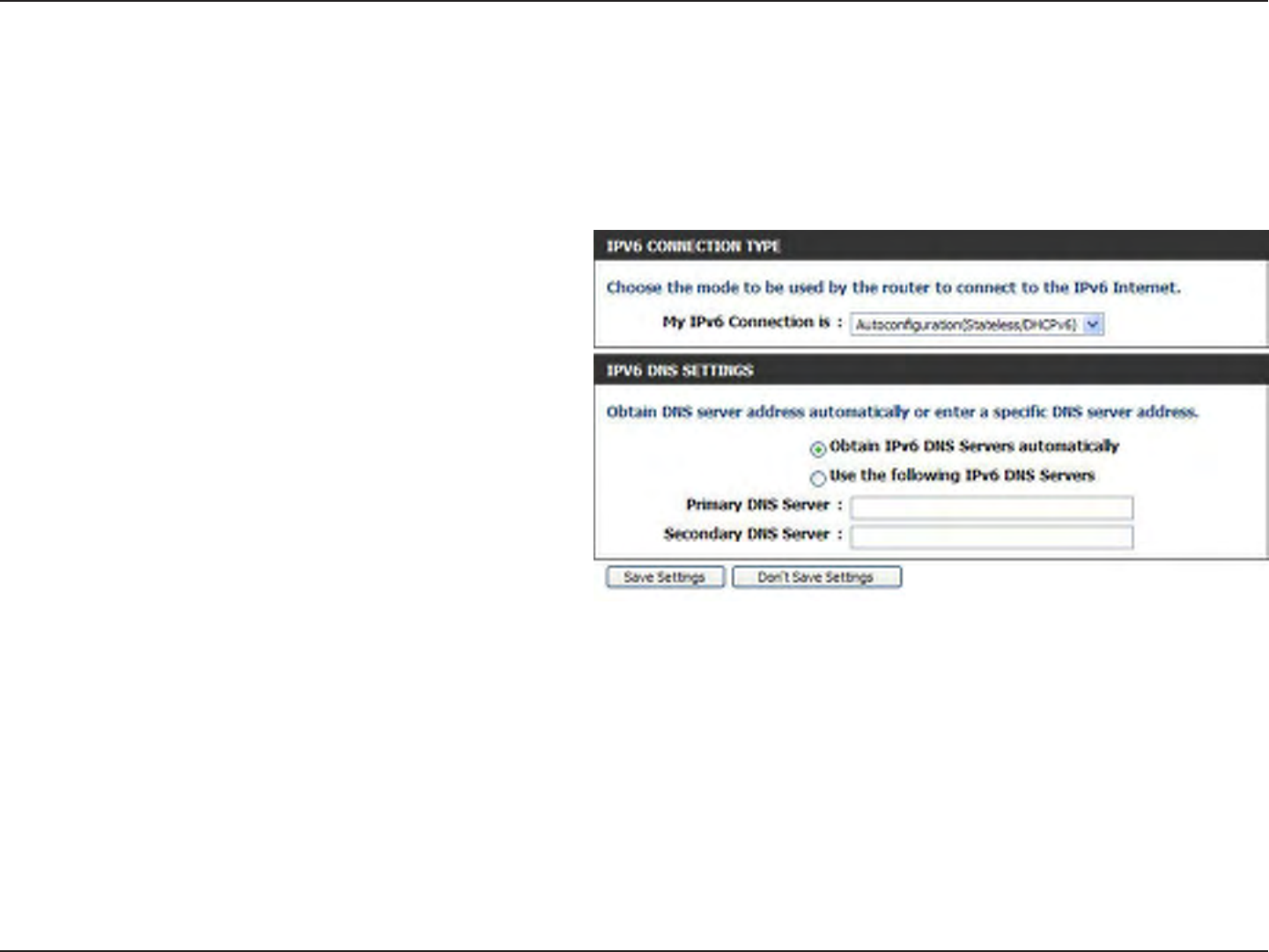
44D-Link DAP-1525 User Manual
Section 3 - Configuration
LAN Setup
Auto-configuration
Click the raio button to directly obtain IPv6
DNS server automatically.
Click the raio button the enter IPv6 DNS
server manually.
Enter the primary DNS server IP address.
Enter the secondary DNS server IP address.
Obtain IPv6
DNS Servers
automatically:
Use the following
IPv6 DNS Servers:
Primary DNS Server:
Secondary DNS
Server:
When using the My IPv6 Connection is drop-down menu to select the IPv6 mode, the LAN IPv6 Address Settings
section will vary based on the selected mode. Select Autoconguration (Stateless/DHCPv6) to see the following
conguration.

45D-Link DAP-1525 User Manual
Section 3 - Configuration
Schedule
Enter a name for your new schedule.
Select a day, a range of days, or All Week to
include every day.
Check All Day - 24 hrs or enter a start and end
time for your schedule.
The list of schedules will be listed here. Click the
Edit icon to make changes or click the Delete icon
to remove the schedule.
Name:
Day(s):
Time:
Schedule Rules
List:

46D-Link DAP-1525 User Manual
Section 3 - Configuration
Admin
Enter a new password for the Administrator
Login Name. The administrator can make
changes to the settings.
Retype the new password for the Administrator
Login Name.
Tick the check box to enable Graphical
Authentication.
Password:
Verify
Password:
Enable Graphical
Authentication:
The “admin” account has the read and write access right. You can also enable Remote Management.

47D-Link DAP-1525 User Manual
Section 3 - Configuration
Time
Select the Time Zone from the drop-down menu.
Tick the check box to enable Daylight Saving
Time.
Click this button to set the device’s time the
same to local PC.
Tick the check box to enable the device to
automatically synchronize with a D-Link NTP
Server. NTP stands for Network Time Protocol.
NTP synchronizes computer clock times in a
network of computers. This will only connect
to a server on the Internet, not a local server.
Select one of the D-Link NTP Servers from
the drop-down menu. The DAP-1525 will then
synchronize its clock to be the same time as
the D-Link Internet
time server. Click the Update Now button to
synchronize with the D-Link Internet time server
immediatley.
To manually input the time, use the drop-down
menus to enter the values in these elds for the
Year, Month, Day, Hour, Minute, and Second.
Time Zone:
Enable
Daylight
Saving:
Sync your
computer’s time
settings:
Automatically
synchronize
with D-Link’s
Internet time
server:
NTP
Server Used:
Set the Time
and Date
Manually:
The Time Conguration option allows you to congure, update, and maintain the correct time on the internal system
clock. From this section you can set the time zone that you are in and set the Time Server. Daylight Saving can also
be congured to automatically adjust the time when needed.
Click the Save Settings button to save any changes made.
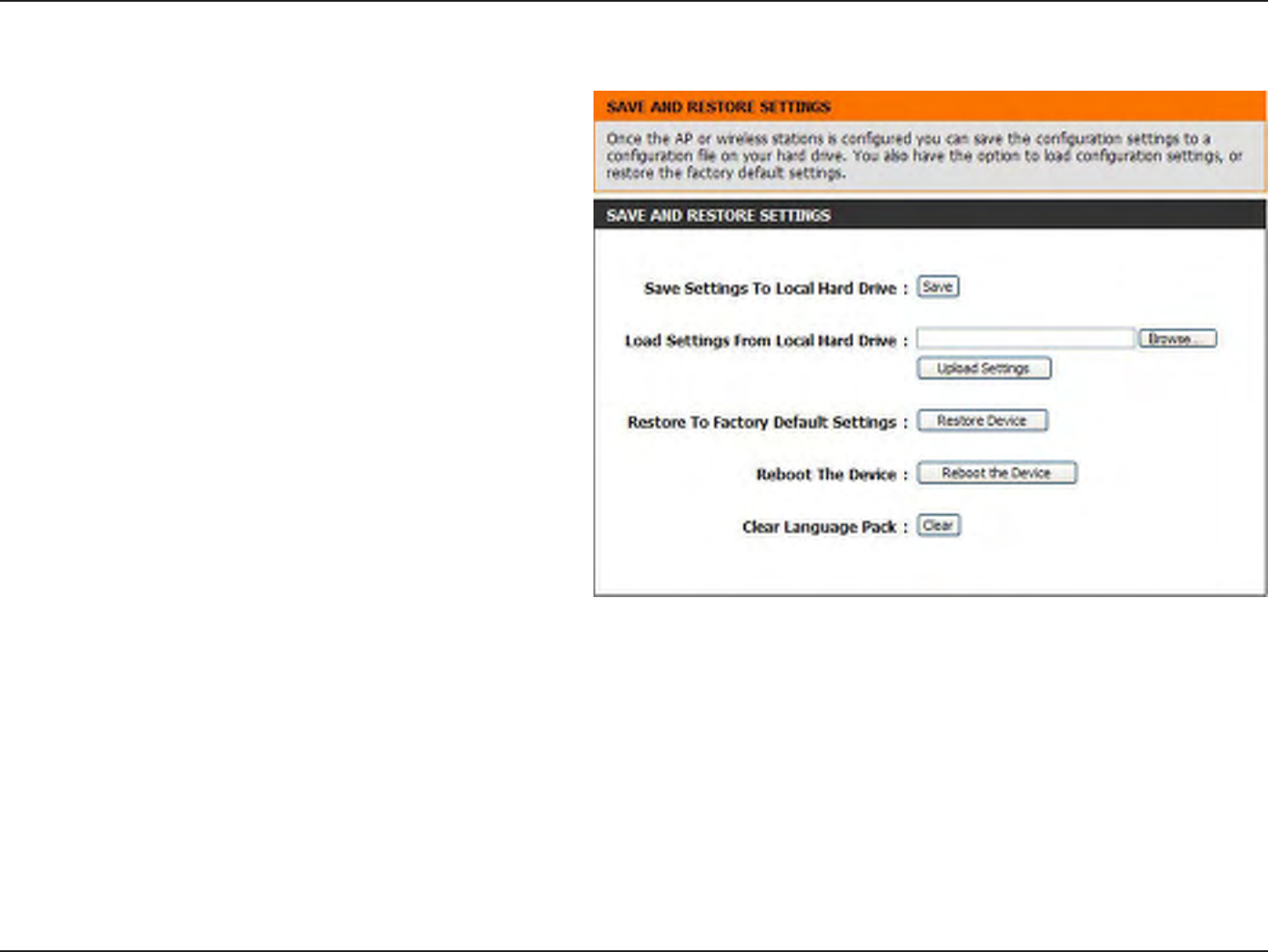
48D-Link DAP-1525 User Manual
Section 3 - Configuration
System
Use this option to save the current Access Point
conguration settings to a le on the hard disk
of the computer you are using. First, click the
Save button. You will then see a le dialog,
where you can select a location and le name
for the settings.
Use this option to load previously saved Access
Point configuration settings. First, use the
Browse control to nd a previously save le of
conguration settings. Then, click the Upload
Settings button to transfer those settings to the
Access Point.
Click the Restore Device button to restore all
conguration settings back to the settings that
were in effect at the time the Access Point was
shipped from the factory. Any settings that have
not been saved will be lost, including any rules
that you have created. If you want to save the
current Access Point conguration settings, use
the Save button above.
Click to reboot the access point.
Click the Clear button to restore the device back
to the English interface version and remove
other languages installed for the system web
pages.
Save Settings
To Local Hard
Drive:
Load Settings
From Local
Hard Drive:
Restore To
Factory
Default
Settings:
Reboot The
Device:
Clear
Language
Pack:
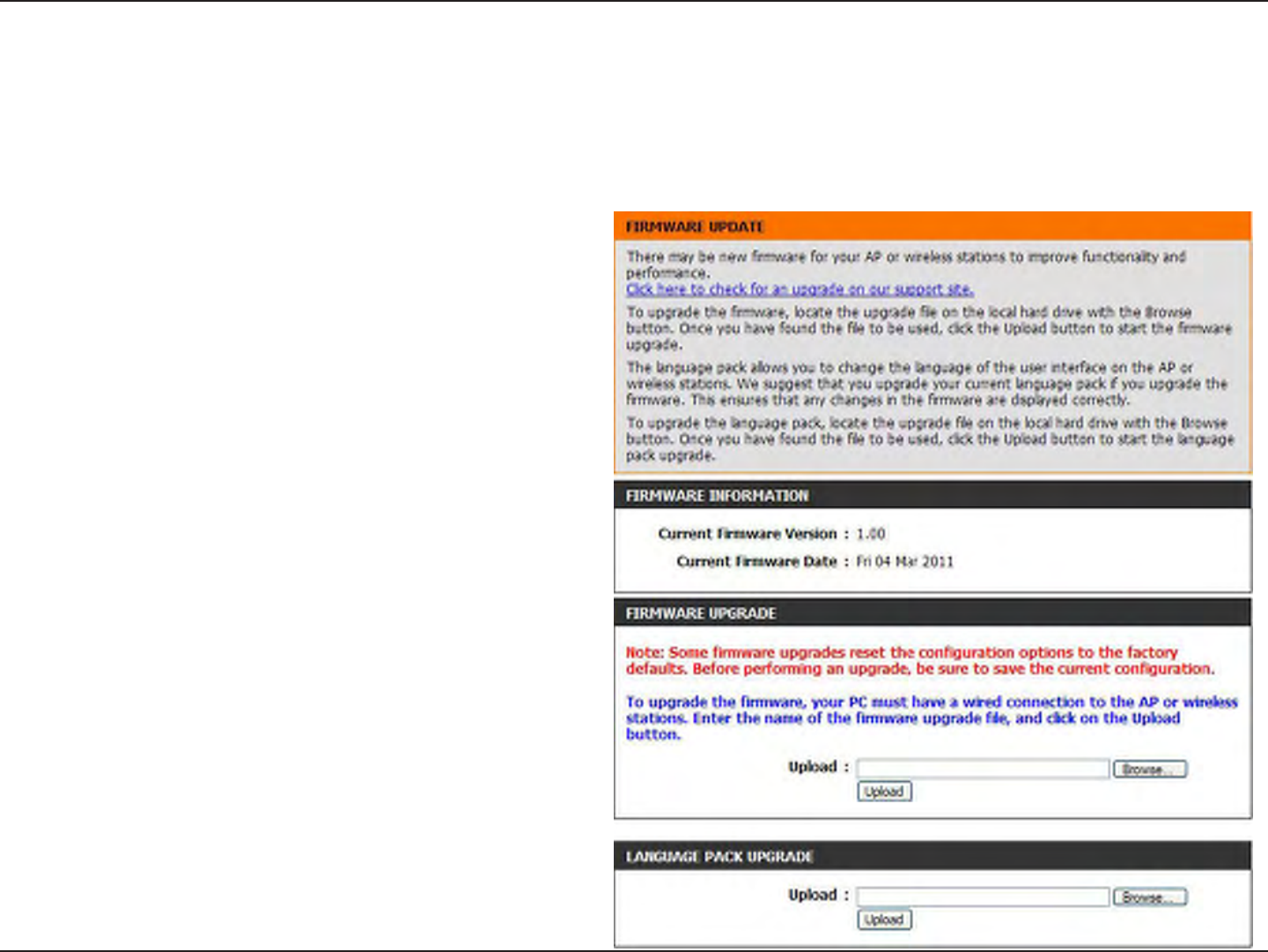
49D-Link DAP-1525 User Manual
Section 3 - Configuration
Firmware
Displays the current rmware version.
Displays the current rmware date.
After you have downloaded the new rmware,
click the Browse control to locate the rmware
update on your hard drive. Click Upload to
complete the rmware upgrade.
This function allows the user to transfer the
language of web user interface from English to
their own language by upgrading the language
pack. Click the Browse button to locate the
desired language pack on your hard drive.
Click Upload to complete the language pack
upgrade.
Current
Firmware
Version:
Current
Firmware
Date:
Firmware
Upgrade:
Language
Pack
Upgrade:
You can upgrade the rmware of the access point here. Please check the D-Link support site for rmware updates at
http://support.dlink.com or simply click the Check Now button located in the Firmware Information section. You can
download rmware upgrades to your hard drive from the D-Link support site. Make sure the rmware you want to use
is on the local hard drive of the computer. Click on Browse to locate the rmware le to be used for the update.
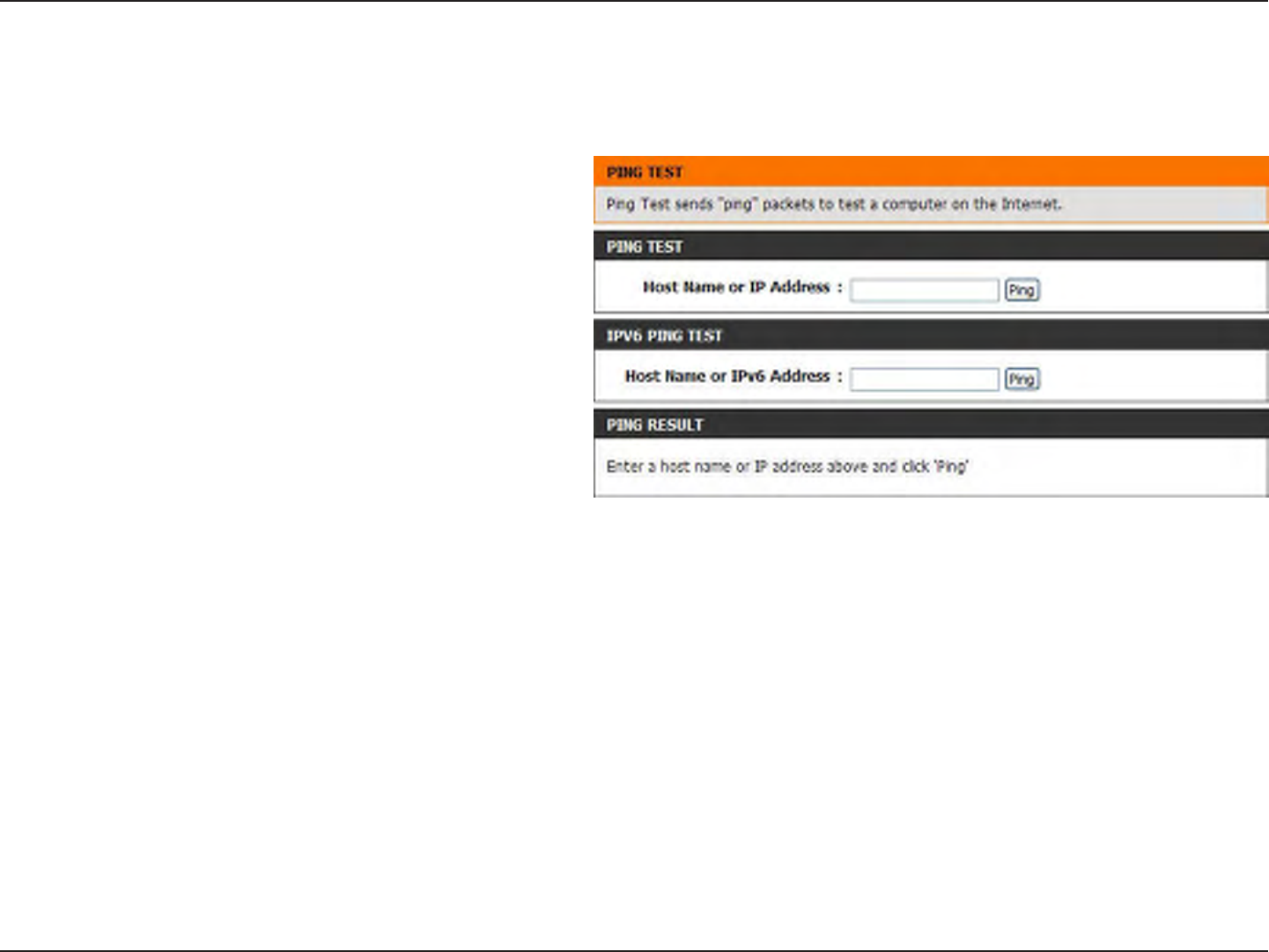
50D-Link DAP-1525 User Manual
Section 3 - Configuration
System Check
The Ping Test / IPv6 Ping Test is used to
send Ping packets to test if a computer is on
the Internet. Enter the host name or IP/IPv6
address that you wish to Ping, and click Ping.
The results of your ping attempts will be
displayed here.
Ping Test /
IPv6 Ping Test:
Ping Result:
The System Check feature allows you to verify the physical connectivity on both the LAN and Internet interface.

51D-Link DAP-1525 User Manual
Section 3 - Configuration
Device Info
This page displays the current information for the DAP-1525. It will display the LAN and Wireless information, in addition
to the rmware version and date the rmware was last updated.
General:
LAN:
Wireless
LAN:
Displays the access point’s time and rmware
version.
Displays the MAC address and the private
(local) IP settings for the access point.
Displays the wireless MAC address and your
wireless settings such as SSID and Channel.
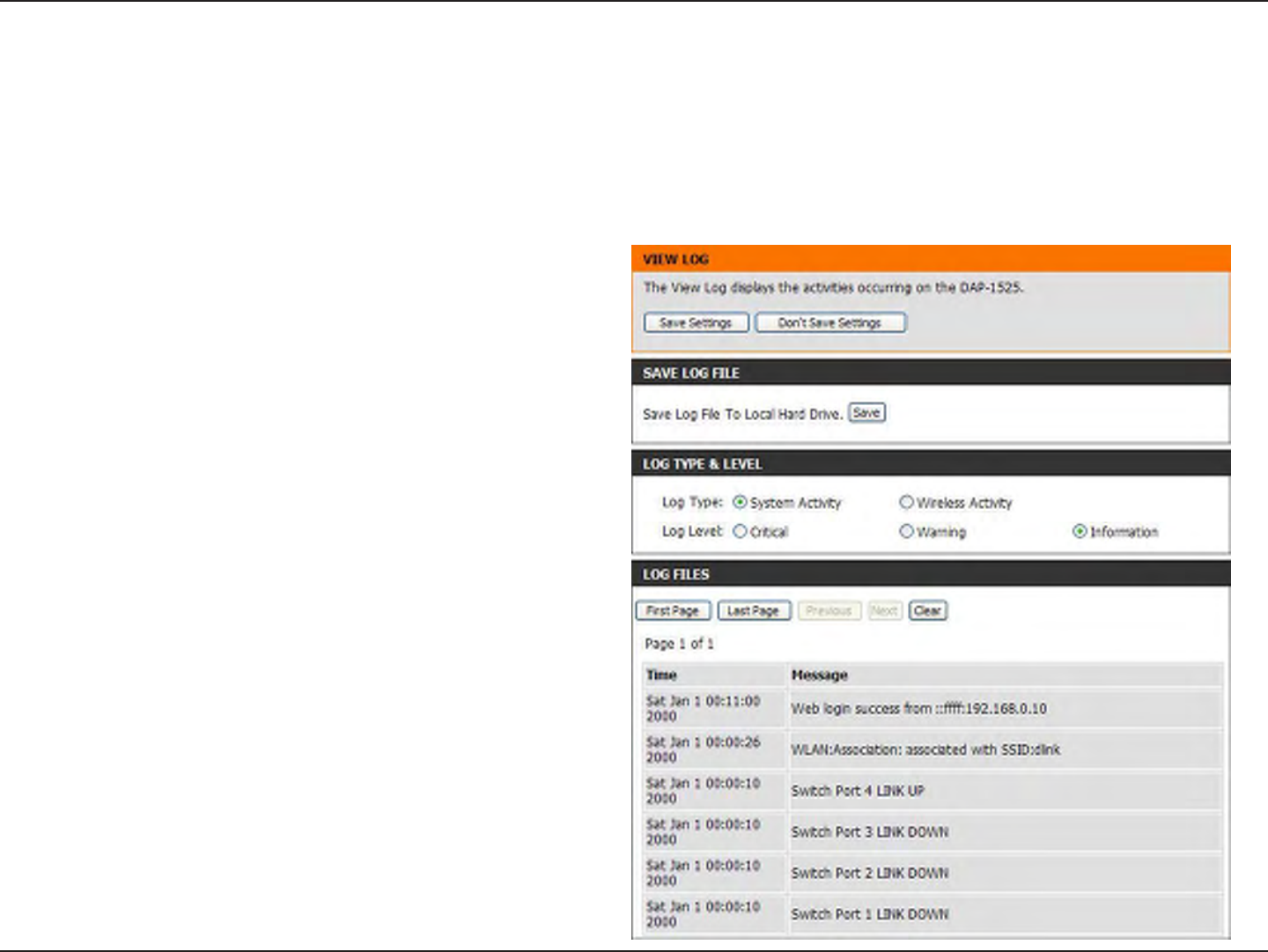
52D-Link DAP-1525 User Manual
Section 3 - Configuration
Logs
Save Log File To
Local Hard Drive:
Log Type & Level:
Log Files:
Click the Save button to save the access point
to a log le on your computer.
Use the radio buttons to select Log type and
level.
Displays log events. Click the Clear button to
delete all the records.
The access point automatically logs (records) events of possible interest in its internal memory. If there isn’t enough
internal memory for all events, logs of older events are deleted, but logs of the latest events are retained. The Logs
option allows you to view the access point logs. You can dene what types of events you want to view and the level
of the events to view. This access point also has external Syslog Server support so you can send the log les to a
computer on your network that is running a Syslog utility.

53D-Link DAP-1525 User Manual
Section 3 - Configuration
IPv6
The IPv6 page displays the detailed IPv6 network connection.
IPv6 Connection
Type:
LAN IPv6 Address:
IPv6 Default
Gateway:
LAN IPv6 Link-
Local Address:
Primary DNS
Server:
Secondary DNS
Server:
Displays IPv6 connection type.
Displays LAN IPv6 address.
Displays the IPv6 address of the default
gateway.
DisplaystheLANIPv6link-localaddress.
DisplaystheIPv6addressoftheprimaryDNS
server.
Displays the IPv6 address of the secondary
DNSserver.
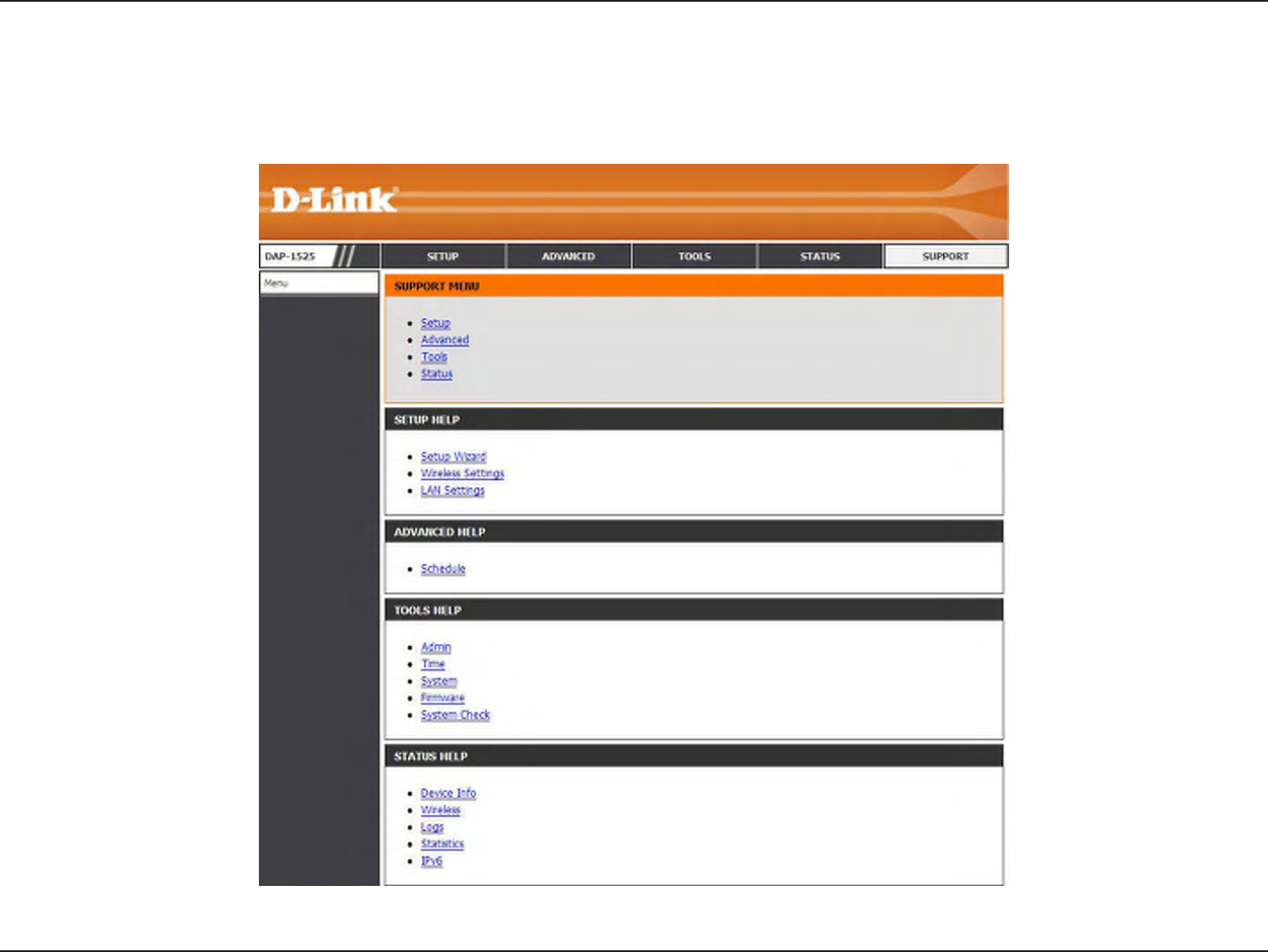
54D-Link DAP-1525 User Manual
Section 3 - Configuration
Support
This page provides all the helpful support information of the Access Point.

55D-Link DAP-1525 User Manual
Section 4 - Wireless Security
Wireless Security
This section will show you the different levels of security you can use to protect your data from intruders. The DAP-
1525 offers the following types of security:
What is WEP?
WEP stands for Wired Equivalent Privacy. It is based on the IEEE 802.11 standard and uses the RC4 encryption
algorithm. WEP provides security by encrypting data over your wireless network so that it is protected as it is transmitted
from one wireless device to another.
To gain access to a WEP network, you must know the key. The key is a string of characters that you create. When
using WEP, you must determine the level of encryption. The type of encryption determines the key length. 128-bit
encryption requires a longer key than 64-bit encryption. Keys are dened by entering in a string in HEX (hexadecimal -
using characters 0-9, A-F) or ASCII (American Standard Code for Information Interchange – alphanumeric characters)
format. ASCII format is provided so you can enter a string that is easier to remember. The ASCII string is converted to
HEX for use over the network. Four keys can be dened so that you can change keys easily.
• WEP(WiredEquivalentPrivacy)
• WPA(Wi-FiProtectedAccess)
• WPA2(Wi-FiProtectedAccess2)
• WPA-PSK(Pre-SharedKey)
• WPA2-PSK(Pre-SharedKey)

56D-Link DAP-1525 User Manual
Section 4 - Wireless Security
What is WPA?
WPA, or Wi-Fi Protected Access, is a Wi-Fi standard that was designed to improve the security features of WEP (Wired
Equivalent Privacy).
The 2 major improvements over WEP:
• ImproveddataencryptionthroughtheTemporalKeyIntegrityProtocol(TKIP).TKIPscramblesthekeysusingahashing
algorithmand,byaddinganintegrity-checkingfeature,ensuresthatthekeyshaven’tbeentamperedwith.WPA2is
basedon802.11iandusesAdvancedEncryptionStandard(AES)insteadofTKIP.
• Userauthentication,whichisgenerallymissinginWEP,throughtheextensibleauthenticationprotocol(EAP).WEP
regulatesaccesstoawirelessnetworkbasedonacomputer’shardware-specicMACaddress,whichisrelativelysimple
tobesniffedoutandstolen.EAPisbuiltonamoresecurepublic-keyencryptionsystemtoensurethatonlyauthorized
networkuserscanaccessthenetwork.
WPA-PSK/WPA2-PSK uses a passphrase or key to authenticate your wireless connection. The key is an alpha-numeric
password between 8 and 63 characters long. The password can include symbols (!?*&_) and spaces. This key must
be the exact same key entered on your wireless Access Point or access point.
WPA/WPA2 incorporates user authentication through the Extensible Authentication Protocol (EAP). EAP is built on a
more secure public key encryption system to ensure that only authorized network users can access the network.
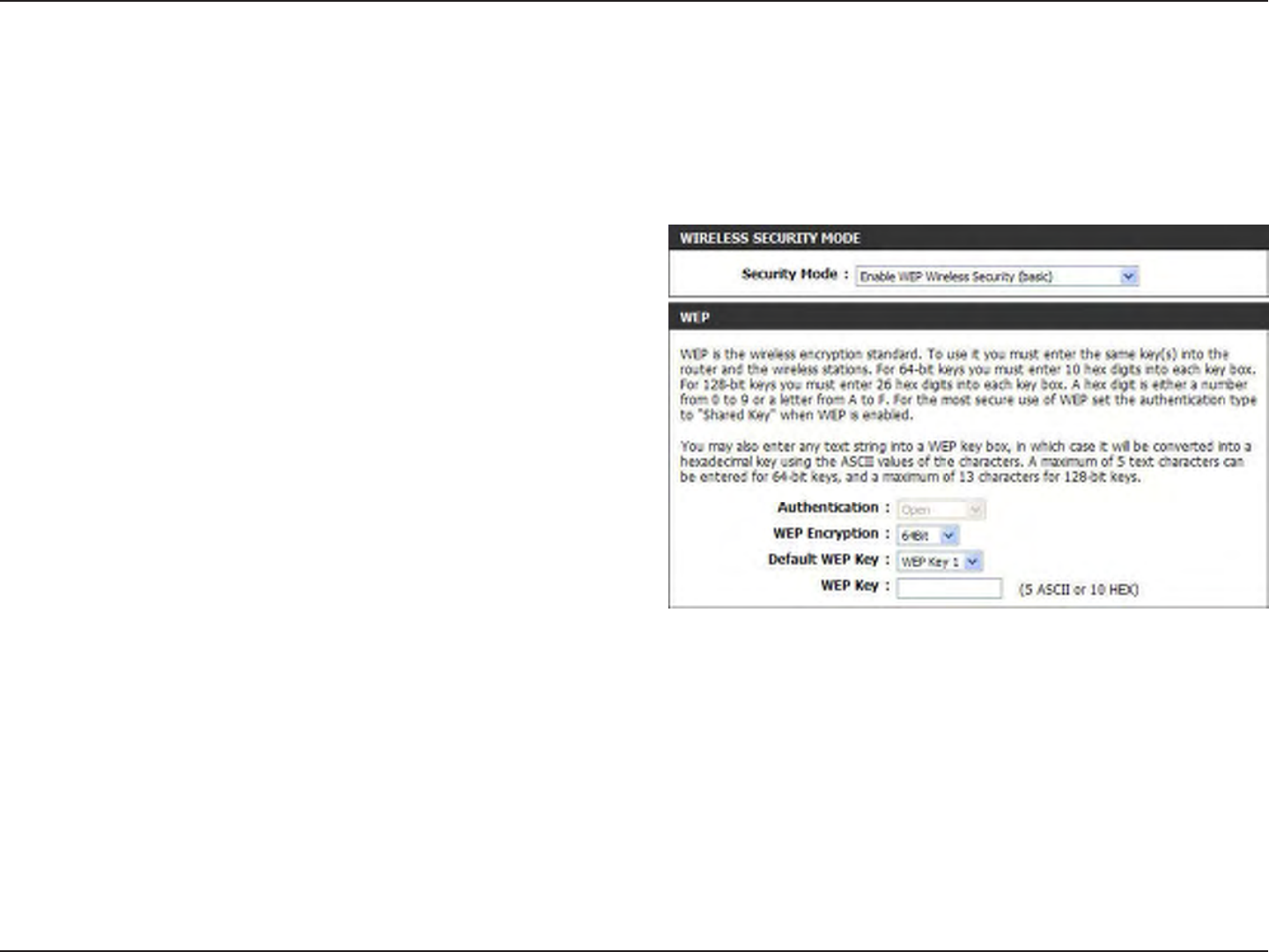
57D-Link DAP-1525 User Manual
Section 4 - Wireless Security
Configure WEP (AP Mode)
It is recommended to enable encryption on your wireless access point before your wireless network adapters. Please
establish wireless connectivity before enabling encryption. Your wireless signal may degrade when enabling encryption
due to the added overhead.
1. Log into the web-based conguration by opening a web
browser and entering the IP address of the access point
(192.168.0.50). Click Setup and then Wireless Settings
on the left side.
2. Select Enable WEP Wireless Security (basic) in the
Security Mode drop-down menu in the Wireless Security
Mode section.
3. Next to WEP Encryption in the WEP section, select the
level of encryption (64-bit or 128-bit). Hex - (recommended)
Letters A-F and numbers 0-9 are valid.
4. Next to Default WEP Key and the rst selection in the
drop-down menu, WEP Key 1. Enter a WEP key that you
create in the WEP Key value and Verify WEP Key value
elds. Make sure you enter this key exactly on all your wireless devices. You may enter up to 4 different keys using
the Default WEP Key drop-down menu.
5. Select Open or Shared Key from the Authentication drop-down menu.
6. Click Save Settings to save your settings. If you are conguring the access point with a wireless adapter, you will
lose connectivity until you enable WEP on your adapter and enter the same WEP key as you did on the access point.

58D-Link DAP-1525 User Manual
Section 4 - Wireless Security
Configure WPA-Personal (AP Mode)
It is recommended to enable encryption on your wireless access point before your wireless network adapters. Please
establish wireless connectivity before enabling encryption. Your wireless signal may degrade when enabling encryption
due to the added overhead.
1. Log into the web-based conguration by opening a web
browserand entering the IP address of the access point
(192.168.0.50). Click Setup and then Wireless Settings
on the left side.
2. Select Enable WPA/WPA2 Wireless Security (enhanced)
from the Security Mode drop-down menu.
3. Select Auto(TKIP/AES), TKIP, or AES from the Cipher
Type drop-down menu. If you have wireless clients that
use both types, use TKIP/AES.
4. Select PSK from the PSK / EAP drop-down menu.
5. Enter a key (passphrase) in the Network Key eld. The key is entered as a pass-phrase in either ASCII or HEX
format. If using ASCII format the pass-phrase must be between 8-63 characters. If using HEX format the pass-phrase
must be 64 characters. The ASCII or HEX pass-phrase must be the same at both ends of the wireless connection.
6. Click Save Settings to save your settings. If you are conguring the Access Point with a wireless adapter, you will
lose connectivity until you enable WPA-PSK on your adapter and enter the same passphrase as you did on the
Access Point.
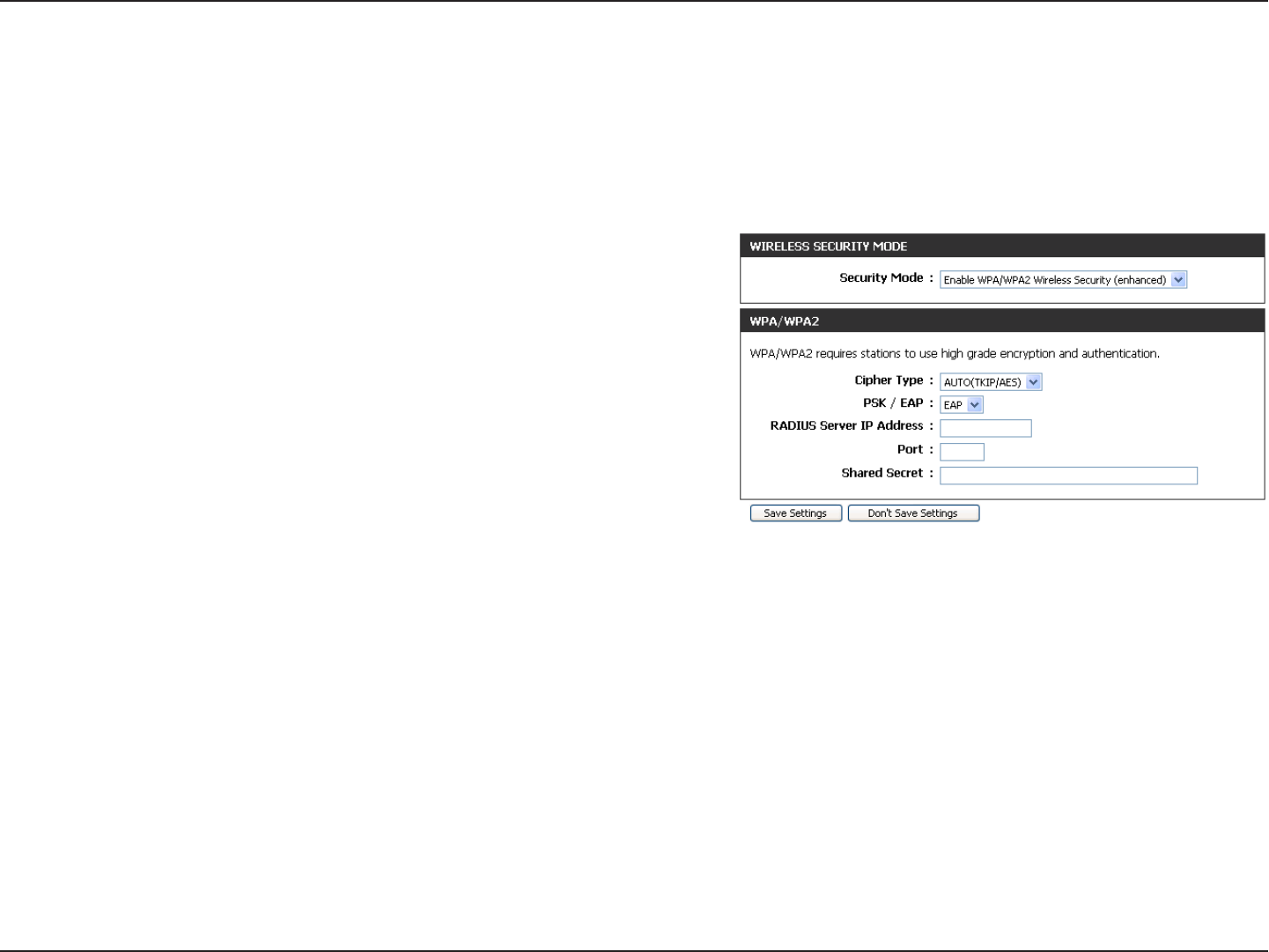
59D-Link DAP-1525 User Manual
Section 4 - Wireless Security
Configure WPA-Enterprise (AP Mode)
It is recommended to enable encryption on your wireless access point before your wireless network adapters. Please
establish wireless connectivity before enabling encryption. Your wireless signal may degrade when enabling encryption
due to the added overhead.
1. Log into the web-based conguration by opening a web browserand
entering the IP address of the access point (192.168.0.50). Click
Setup and then Wireless Settings on the left side.
2. Select Enable WPA/WPA2 Wireless Security (enhanced) from
the Security Mode drop-down menu.
3. 3. Select Auto(TKIP/AES), TKIP, or AES from the Cipher Type
drop-down menu. If you have wireless clients that use both types,
use TKIP/AES.
4. Select EAP from the PSK / EAP drop-down menu.
5. Enter the IP Address of your RADIUS server in the RADIUS Server IP Address eld.
6. Enter the port you are using with your RADIUS server in the Port eld.
7. Enter the security key in the Shared Secret eld.
8. Click Save Settings to save your settings. If you are conguring the Access Point with a wireless adapter, you will
lose connectivity until you enable WPA-Enterprise (RADIUS) on your adapter and enter the same passphrase as
you did on the Access Point.
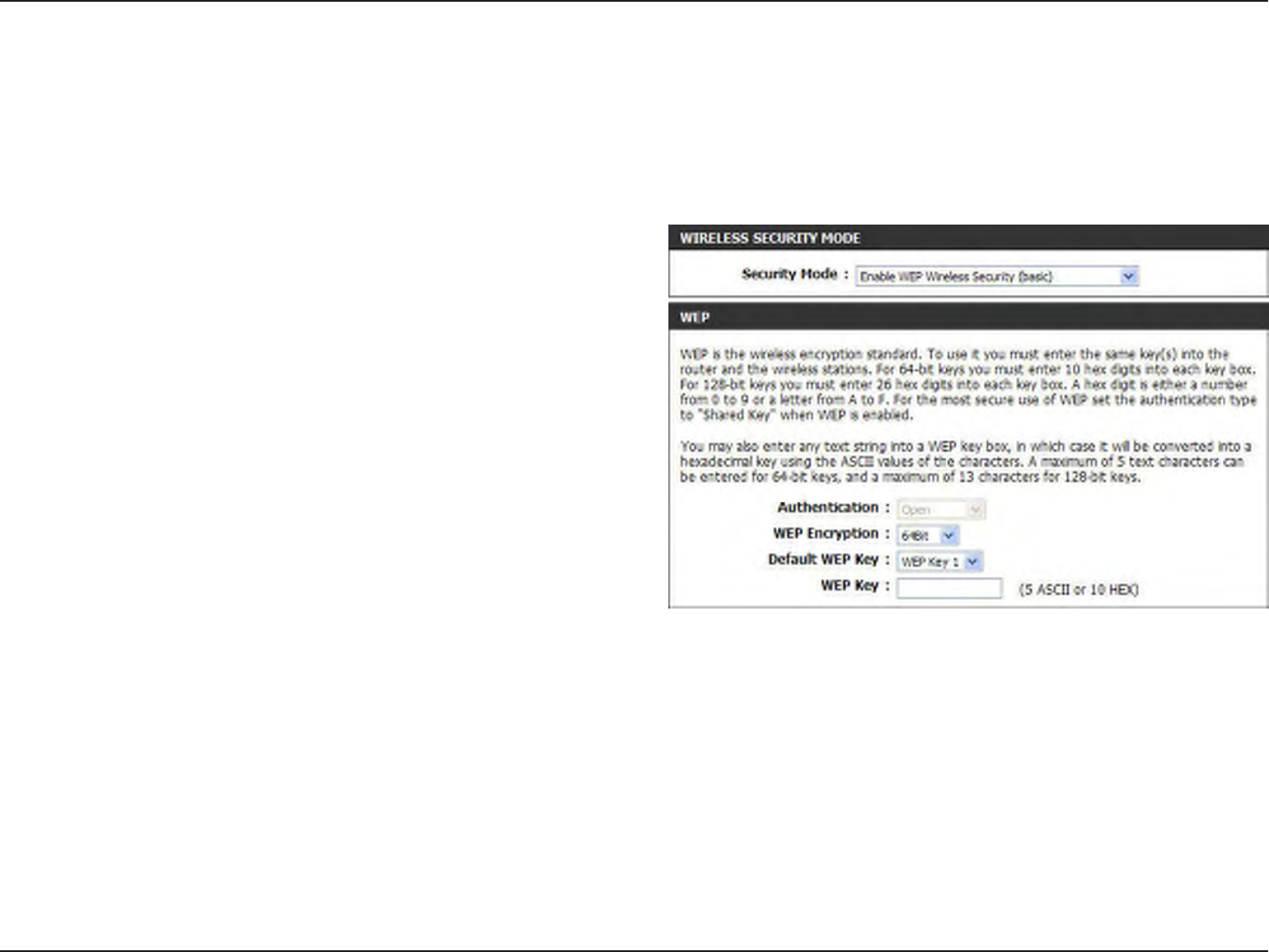
60D-Link DAP-1525 User Manual
Section 4 - Wireless Security
Configure WEP (Bridge Mode)
It is recommended to enable encryption on your wireless access point before your wireless network adapters. Please
establish wireless connectivity before enabling encryption. Your wireless signal may degrade when enabling encryption
due to the added overhead.
1. Log into the web-based conguration by opening a web
browser and entering the IP address of the access point
(192.168.0.50). Click Setup and then Wireless Settings
on the left side.
2. Select Enable WEP Wireless Security (basic) in the
Security Mode drop-down menu in the Wireless Security
Mode section.
3. Next to WEP Encryption in the WEP section, select the
level of encryption (64-bit or 128-bit). Hex - (recommended)
Letters A-F and numbers 0-9 are valid.
4. Next to Default WEP Key and the rst selection in the
drop-down menu, WEP Key 1. Enter a WEP key that you
create in the WEP Key value and Verify WEP Key value
elds. Make sure you enter this key exactly on all your wireless devices. You may enter up to 4 different keys using
the Default WEP Key drop-down menu.
5. Click Save Settings to save your settings. If you are conguring the access point with a wireless adapter, you will
lose connectivity until you enable WEP on your adapter and enter the same WEP key as you did on the access point.

61D-Link DAP-1525 User Manual
Section 4 - Wireless Security
Configure WPA-Personal (Bridge Mode)
It is recommended to enable encryption on your wireless Access Point before your wireless network adapters. Please
establish wireless connectivity before enabling encryption. Your wireless signal may degrade when enabling encryption
due to the added overhead.
1. Log into the web-based conguration by opening a web
browser and entering the IP address of the access point
(192.168.0.50). Click Setup and then Wireless Settings
on the left side.
2. Select Enable WPA Wireless Security, or Enable WPA2
Wireless Security from the Security Mode drop-down
menu.
3. Select TKIP, or AES from the Cipher Type drop-down
menu.
4. Select PSK from the PSK drop-down menu.
5. Enter a key (passphrase) in the Network Key eld. The key is entered as a pass-phrase in either ASCII or HEX
format. If using ASCII format the pass-phrase must be between 8-63 characters. If using HEX format the pass-phrase
must be 64 characters. The ASCII or HEX pass-phrase must be the same at both ends of the wireless connection.
6. Click Save Settings to save your settings. If you are conguring the Access Point with a wireless adapter, you will
lose connectivity until you enable WPA-PSK on your adapter and enter the same passphrase as you did on the
Access Point.

62D-Link DAP-1525 User Manual
Section 5 - Connecting to a Wireless Network
Connect to a Wireless Network
Using Windows Vista®
Windows Vista® users may use the built-in wireless utility. If you are using another company’s utility or Windows® 2000,
please refer to the user manual of your wireless adapter for help with connecting to a wireless network. Most utilities
will have a “site survey” option similar to the Windows Vista® utility as seen below.
Right-click on the wireless computer icon in your system tray
(lower-right corner next to the time). Select Connect to a
network.
If you receive the Wireless Networks Detected bubble, click
on the center of the bubble to access the utility.
or
The utility will display any available wireless networks in your
area. Click on a network (displayed using the SSID) and click
the Connect button.
If you get a good signal but cannot access the Internet, check
you TCP/IP settings for your wireless adapter. Refer to the
Networking Basics section in this manual for more information.
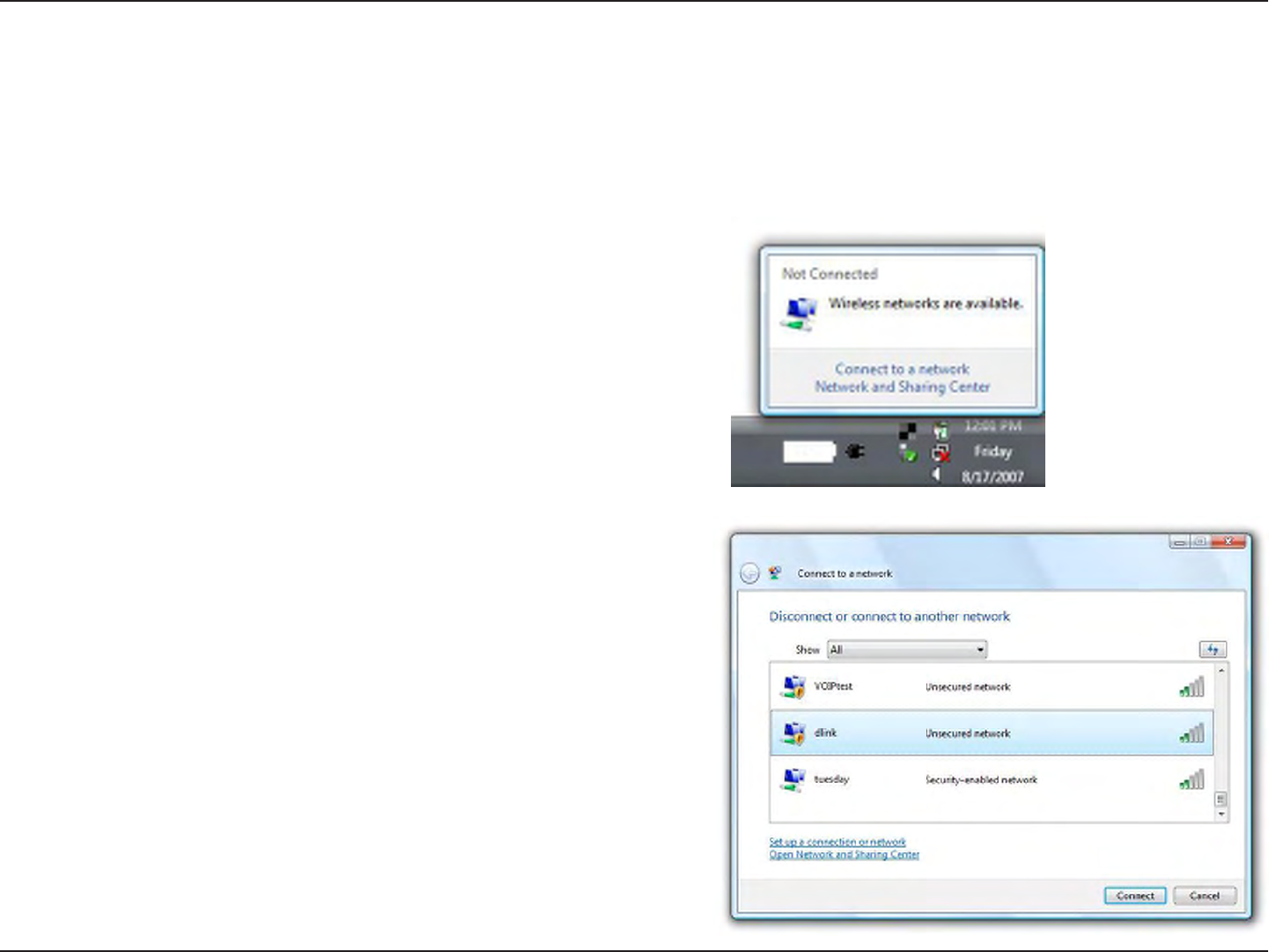
63D-Link DAP-1525 User Manual
Section 5 - Connecting to a Wireless Network
Configure WPA/WPA2
It is recommended to enable wireless security (WPA/WPA2) on your wireless Access Point or access point before
conguring your wireless adapter. If you are joining an existing network, you will need to know the security key or
passphrase being used.
2. Highlight the wireless network (SSID) you would like to
connect to and click Connect.
1. Open the Windows Vista® Wireless Utility by right-clicking
on the wireless computer icon in your system tray (lower
right corner of screen). Select Connect to a network.
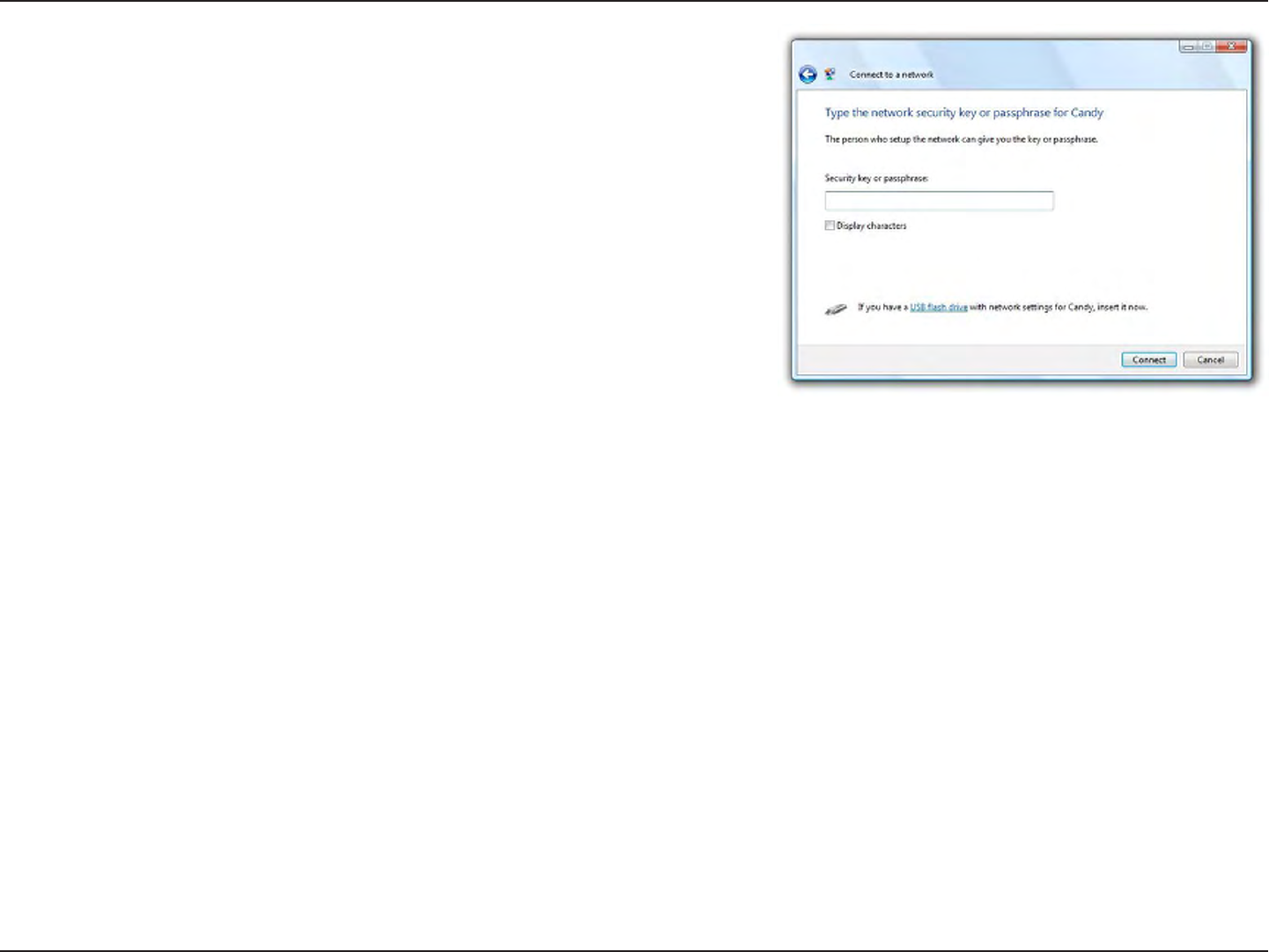
64D-Link DAP-1525 User Manual
Section 5 - Connecting to a Wireless Network
3. Enter the same security key or passphrase that is on your Access
Point and click Connect.
It may take 20-30 seconds to connect to the wireless network. If the
connection fails, please verify that the security settings are correct.
The key or passphrase must be exactly the same as on the wireless
Access Point.

65D-Link DAP-1525 User Manual
Section 5 - Connecting to a Wireless Network
Connect Using WCN 2.0
The Access Point supports Wi-Fi protection, referred to as WCN 2.0 in Windows Vista®. The following instructions for
setting this up depends on whether you are using Windows Vista® to congure the Access Point or third party software.
When you rst set up the Access Point, Wi-Fi protection is disabled and uncongured. To enjoy the benets of Wi-Fi
protection, the Access Point must be both enabled and congured. There are three basic methods to accomplish this:
use Windows Vista’s built-in support for WCN 2.0, use software provided by a third party, or manually congure.
If you are running Windows Vista®, log into the Access Point and click the Enable checkbox in the Advanced > Wi-Fi
Protected Setup window. Use the Current PIN that is displayed in the PIN Settings section of Advanced > Wi-Fi
Protected Setup window or choose to click the Generate New PIN button or Reset PIN to Default button.
If you are using third party software to set up Wi-Fi Protection, carefully follow the directions. When you are nished,
proceed to the next section to set up the newly-congured Access Point.
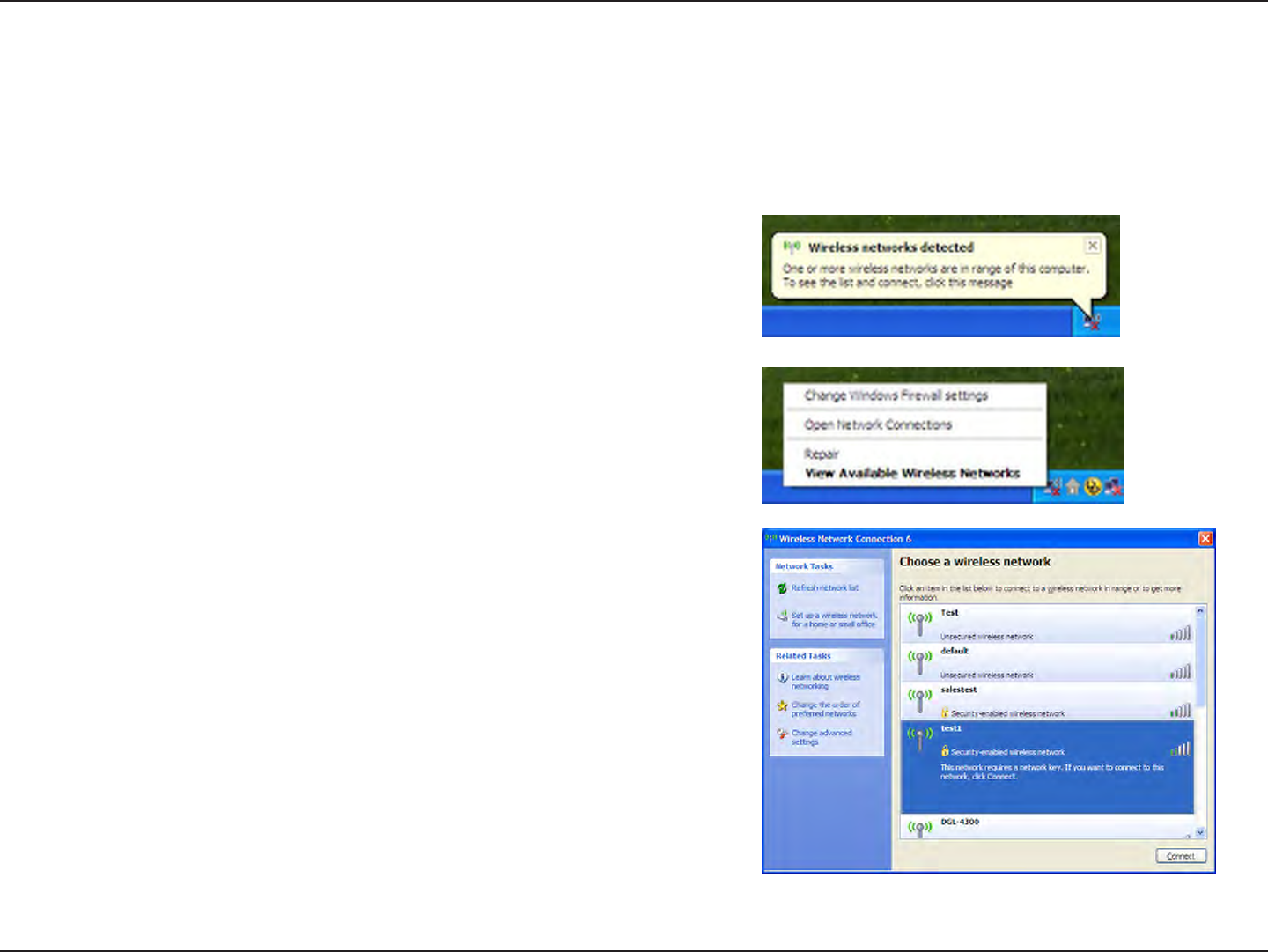
66D-Link DAP-1525 User Manual
Section 5 - Connecting to a Wireless Network
Using Windows® XP
Windows® XP users may use the built-in wireless utility (Zero Conguration Utility). The following instructions are for
Service Pack 3 users. If you are using another company’s utility or Windows® 2000, please refer to the user manual
of your wireless adapter for help with connecting to a wireless network. Most utilities will have a “site survey” option
similar to the Windows® XP utility as seen below.
If you receive the Wireless Networks Detected bubble, click
on the center of the bubble to access the utility.
or
Right-click on the wireless computer icon in your system tray
(lower-right corner next to the time). Select View Available
Wireless Networks.
The utility will display any available wireless networks in your
area. Click on a network (displayed using the SSID) and click
the Connect button.
If you get a good signal but cannot access the Internet, check
you TCP/IP settings for your wireless adapter. Refer to the
Networking Basics section in this manual for more information.
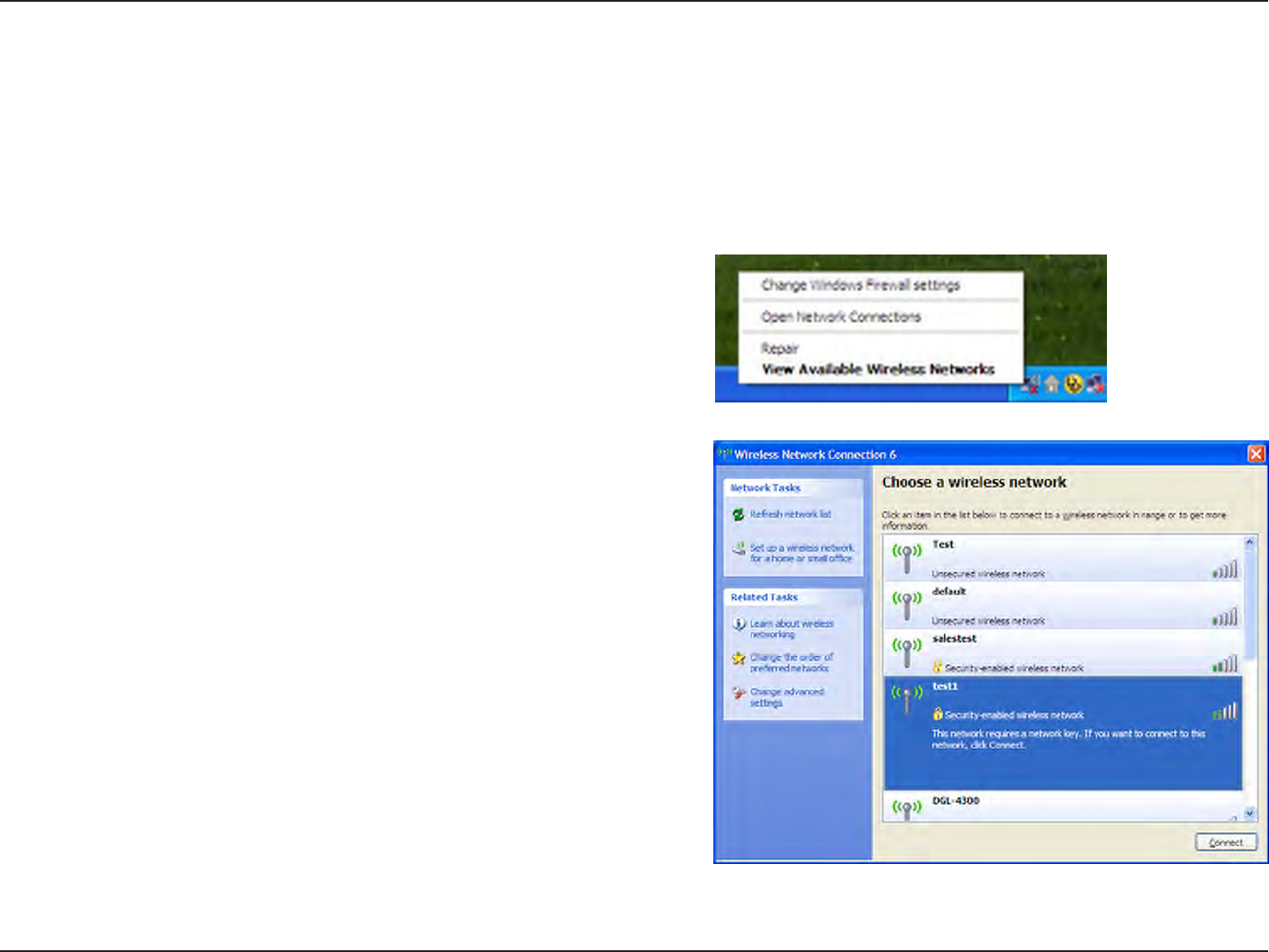
67D-Link DAP-1525 User Manual
Section 5 - Connecting to a Wireless Network
Configure WPA2-PSK
It is recommended to enable WPA2-PSK on your wireless Access Point or access point before conguring your wireless
adapter. If you are joining an existing network, you will need to know the WPA2-PSK key being used.
2. Highlight the wireless network (SSID) you would like to
connect to and click Connect.
1. Open the Windows® XP Wireless Utility by right-clicking
on the wireless computer icon in your system tray
(lower-right corner of screen). Select View Available
Wireless Networks.
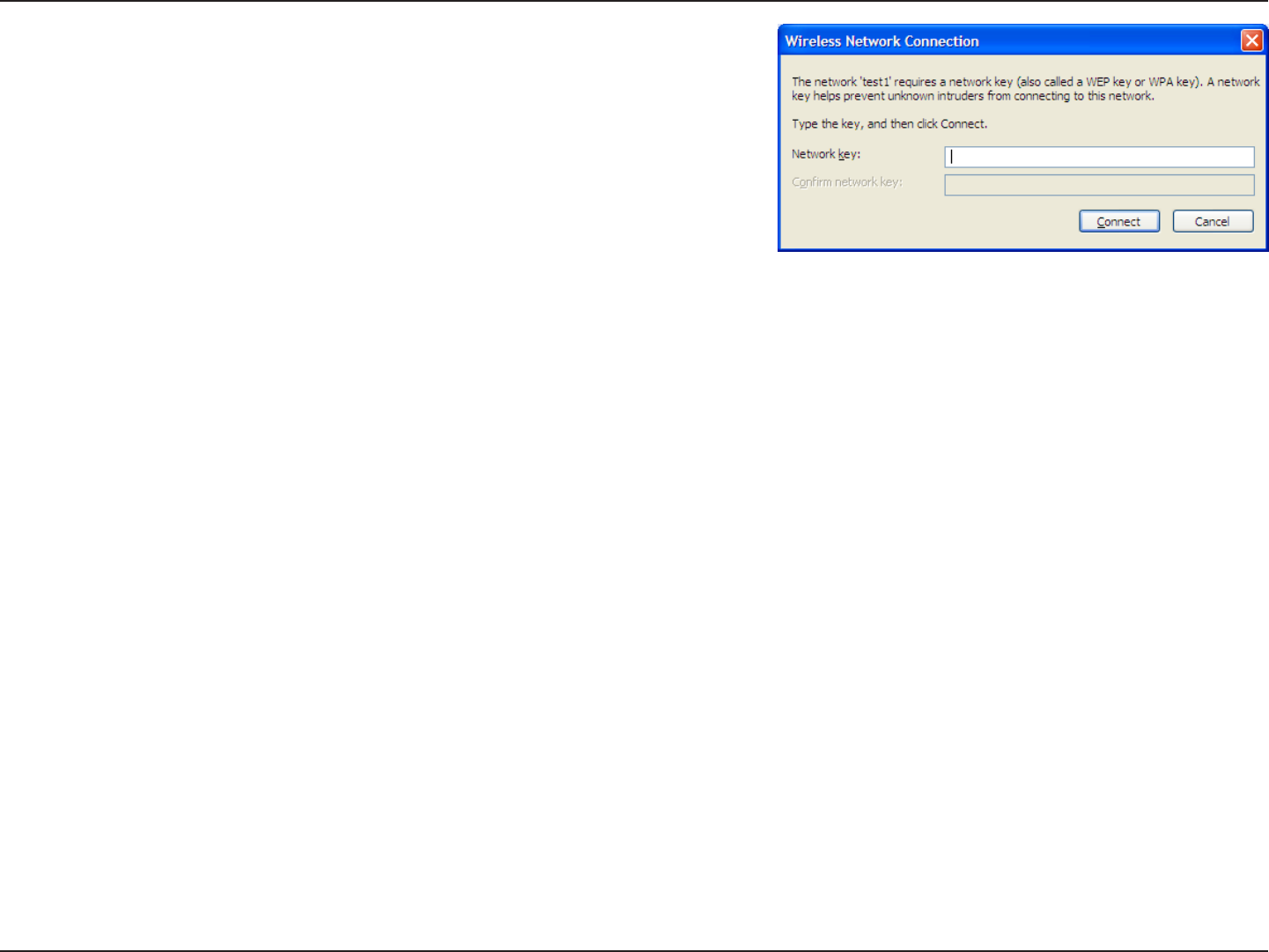
68D-Link DAP-1525 User Manual
Section 5 - Connecting to a Wireless Network
3. The Wireless Network Connection box will appear. Enter the
WPA2-PSK passphrase and click Connect.
It may take 20-30 seconds to connect to the wireless network. If the
connection fails, please verify that the WPA-PSK settings are correct.
The WPA-PSK passphrase must be exactly the same as on the
wireless Access Point.

69D-Link DAP-1525 User Manual
Section 6 - Troubleshooting
Troubleshooting
This chapter provides solutions to problems that can occur during the installation and operation of the DAP-1525.
Read the following descriptions if you are having problems. (The examples below are illustrated in Windows® XP. If
you have a different operating system, the screen shots on your computer will look similar to the following examples.)
1. Why can’t I access the Web-based conguration utility?
When entering the IP address of the D-Link Access Point (192.168.0.50 for example), you are not connecting to a
Website on the Internet or have to be connected to the Internet. The device has the utility built-in to a ROM chip in the
device itself. Your computer must be on the same IP subnet to connect to the Web-based utility.
• Make sure you have an updated Java-enabled Web browser. We recommend the following:
• InternetExplorer6.0orhigher
• Mozilla3.0orhigher
• GoogleChrome2.0orhigher
• AppleSafari3.0orhigher(withJava1.3.1orhigher)
• Verify physical connectivity by checking for solid link lights on the device. If you do not get a solid link light, try using
a different cable or connect to a different port on the device if possible. If the computer is turned off, the link light may
not be on.
• Disable any Internet security software running on the computer. Software rewalls such as Zone Alarm, Black Ice,
Sygate, Norton Personal Firewall, and Windows® XP rewall may block access to the conguration pages. Check the
help les included with your rewall software for more information on disabling or conguring it.

70D-Link DAP-1525 User Manual
Section 6 - Troubleshooting
• Congure your Internet settings:
• GotoStart>Settings>ControlPanel.Double-clicktheInternetOptionsIcon.FromtheSecuritytab,clickthebutton
torestorethesettingstotheirdefaults.
• ClicktheConnectiontabandsetthedial-upoptiontoNeverDialaConnection.ClicktheLANSettingsbutton.Make
surenothingischecked.ClickOK.
• GototheAdvancedtabandclickthebuttontorestorethesesettingstotheirdefaults.ClickOKthreetimes.
• CloseyourWebbrowser(ifopen)andopenit.
• Access the Web management. Open your Web browser and enter the IP address of your D-Link Access Point in the
address bar. This should open the login page for your the Web management.
• If you still cannot access the conguration, unplug the power to the Access Point for 10 seconds and plug back in.
Wait about 30 seconds and try accessing the conguration. If you have multiple computers, try connecting using a
different computer.
2. What can I do if I forgot my password?
If you forgot your password, you must reset your Access Point. Unfortunately this process will change all your settings
back to the factory defaults.
To reset the Access Point, locate the reset button (hole) on the rear panel of the unit. With the Access Point powered
on, use a paperclip to hold the button down for 10 seconds. Release the button and the Access Point will go through
its reboot process. Wait about 30 seconds to access the Access Point. The default IP address is 192.168.0.50. When
logging in, the username is admin and leave the password box empty.

71D-Link DAP-1525 User Manual
Appendix A - Wireless Basics
D-Link wireless products are based on industry standards to provide easy-to-use and compatible high-speed wireless
connectivity within your home, business or public access wireless networks. Strictly adhering to the IEEE standard,
the D-Link wireless family of products will allow you to securely access the data you want, when and where you want
it. You will be able to enjoy the freedom that wireless networking delivers.
A wireless local area network (WLAN) is a cellular computer network that transmits and receives data with radio signals
instead of wires. Wireless LANs are used increasingly in both home and ofce environments, and public areas such
as airports, coffee shops and universities. Innovative ways to utilize WLAN technology are helping people to work and
communicate more efciently. Increased mobility and the absence of cabling and other xed infrastructure have proven
to be benecial for many users.
Wireless users can use the same applications they use on a wired network. Wireless adapter cards used on laptop
and desktop systems support the same protocols as Ethernet adapter cards.
Under many circumstances, it may be desirable for mobile network devices to link to a conventional Ethernet LAN in
order to use servers, printers or an Internet connection supplied through the wired LAN. A Wireless Access Point is
a device used to provide this link.
Wireless Basics

72D-Link DAP-1525 User Manual
Appendix A - Wireless Basics
What is Wireless?
Wireless or Wi-Fi technology is another way of connecting your computer to the network without using wires.
Wi-Fi uses radio frequency to connect wirelessly, so you have the freedom to connect computers anywhere
in your home or ofce network.
Why D-Link Wireless?
D-Link is the worldwide leader and award winning designer, developer, and manufacturer of networking
products. D-Link delivers the performance you need at a price you can afford. D-Link has all the products
you need to build your network.
How does wireless work?
Wireless works similar to how cordless phone work, through radio signals to transmit data from one point
A to point B. But wireless technology has restrictions as to how you can access the network. You must be
within the wireless network range area to be able to connect your computer. There are two different types
of wireless networks Wireless Local Area Network (WLAN), and Wireless Personal Area Network (WPAN).
Wireless Local Area Network (WLAN)
In a wireless local area network, a device called an access point (AP) connects computers to the network.
The access point has a small antenna attached to it, which allows it to transmit data back and forth over
radio signals. With an indoor access point as seen in the picture, the signal can travel up to 300 feet. With
an outdoor access point the signal can reach out up to 30 miles to serve places like manufacturing plants,
industrial locations, college and high school campuses, airports, golf courses, and many other outdoor venues.

73D-Link DAP-1525 User Manual
Appendix A - Wireless Basics
Wireless Personal Area Network (WPAN)
Bluetooth is the industry standard wireless technology used for WPAN. Bluetooth devices in WPAN operate
in a range up to 30 feet away.
Compared to WLAN the speed and wireless operation range are both less than WLAN, but in return it
doesn’t use nearly as much power which makes it ideal for personal devices, such as mobile phones, PDAs,
headphones, laptops, speakers, and other devices that operate on batteries.
Who uses wireless?
Wireless technology as become so popular in recent years that almost everyone is using it, whether it’s for
home, ofce, business, D-Link has a wireless solution for it.
Home
• Giveseveryoneathomebroadbandaccess
• SurftheWeb,checke-mail,instantmessage,andetc.
• Getsridofthecablesaroundthehouse
• Simpleandeasytouse
Small Ofce and Home Ofce
• Stayontopofeverythingathomeasyouwouldatofce
• Remotelyaccessyourofcenetworkfromhome
• ShareInternetconnectionandprinterwithmultiplecomputers
• Noneedtodedicateofcespace

74D-Link DAP-1525 User Manual
Appendix A - Wireless Basics
Where is wireless used?
Wireless technology is expanding everywhere not just at home or ofce. People like the freedom of mobility
and it’s becoming so popular that more and more public facilities now provide wireless access to attract people.
The wireless connection in public places is usually called “hotspots”.
Using a D-Link CardBus Adapter with your laptop, you can access the hotspot to connect to Internet from
remote locations like: Airports, Hotels, Coffee Shops, Libraries, Restaurants, and Convention Centers.
Wireless network is easy to setup, but if you’re installing it for the rst time it could be quite a task not knowing
where to start. That’s why we’ve put together a few setup steps and tips to help you through the process of
setting up a wireless network.
Tips
Here are a few things to keep in mind, when you install a wireless network.
Centralize your Access Point or access point
Make sure you place the Access Point/access point in a centralized location within your network for the best
performance. Try to place the Access Point/access point as high as possible in the room, so the signal gets
dispersed throughout your home. If you have a two-story home, you may need a repeater to boost the signal
to extend the range.
Eliminate Interference
Place home appliances such as cordless telephones, microwaves, and televisions as far away as possible
from the Access Point/access point. This would signicantly reduce any interference that the appliances might
cause since they operate on same frequency.

75D-Link DAP-1525 User Manual
Appendix A - Wireless Basics
Security
Don’t let your next-door neighbors or intruders connect to your wireless network. Secure your wireless
network by turning on the WPA or WEP security feature on the Access Point. Refer to product manual for
detail information on how to set it up.
There are basically two modes of networking:
• Infrastructure–AllwirelessclientswillconnecttoanaccesspointorwirelessAccessPoint.
• Ad-Hoc–Directlyconnectingtoanothercomputer,forpeer-to-peercommunication,usingwirelessnetworkadapters
oneachcomputer,suchastwoormorewirelessnetworkCardBusadapters.
An Infrastructure network contains an access point or wireless Access Point. All the wireless devices, or clients, will
connect to the wireless Access Point or access point.
An Ad-Hoc network contains only clients, such as laptops with wireless CardBus adapters. All the adapters must be
in Ad-Hoc mode to communicate.
Wireless Modes
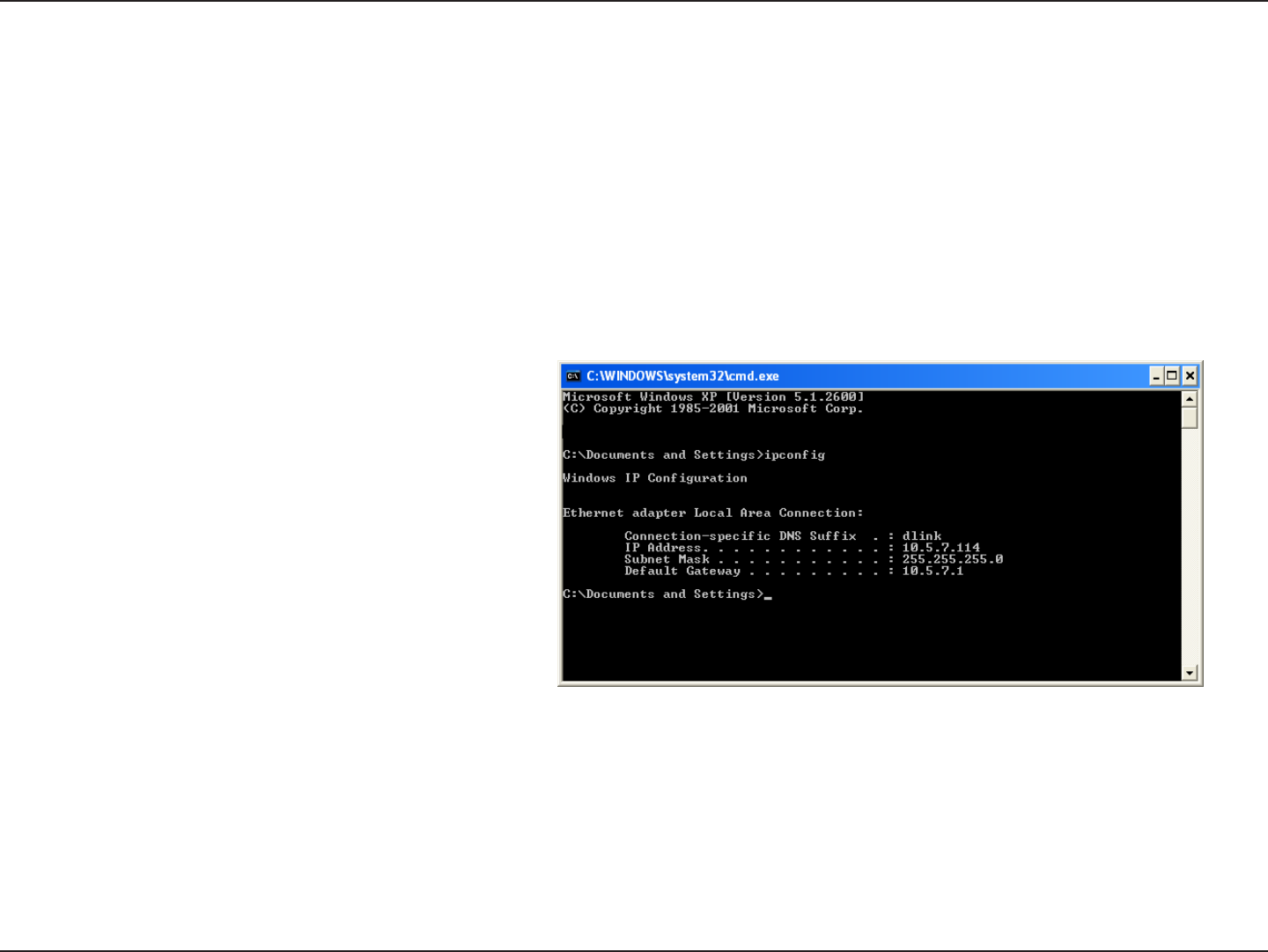
76D-Link DAP-1525 User Manual
Appendix B - Networking Basics
Networking Basics
Check your IP address
After you install your adapter, by default, the TCP/IP settings should be set to obtain an IP address from a DHCP server
(i.e. wireless Access Point) automatically. To verify your IP address, please follow the steps below.
Click on Start > Run. In the run box type cmd and click OK. (Windows Vista® users type cmd in the Start Search box.)
At the prompt, type ipcong and press Enter.
This will display the IP address, subnet mask, and
the default gateway of your adapter.
If the address is 0.0.0.0, check your adapter
installation, security settings, and the settings
on your Access Point. Some rewall software
programs may block a DHCP request on newly
installed adapters.
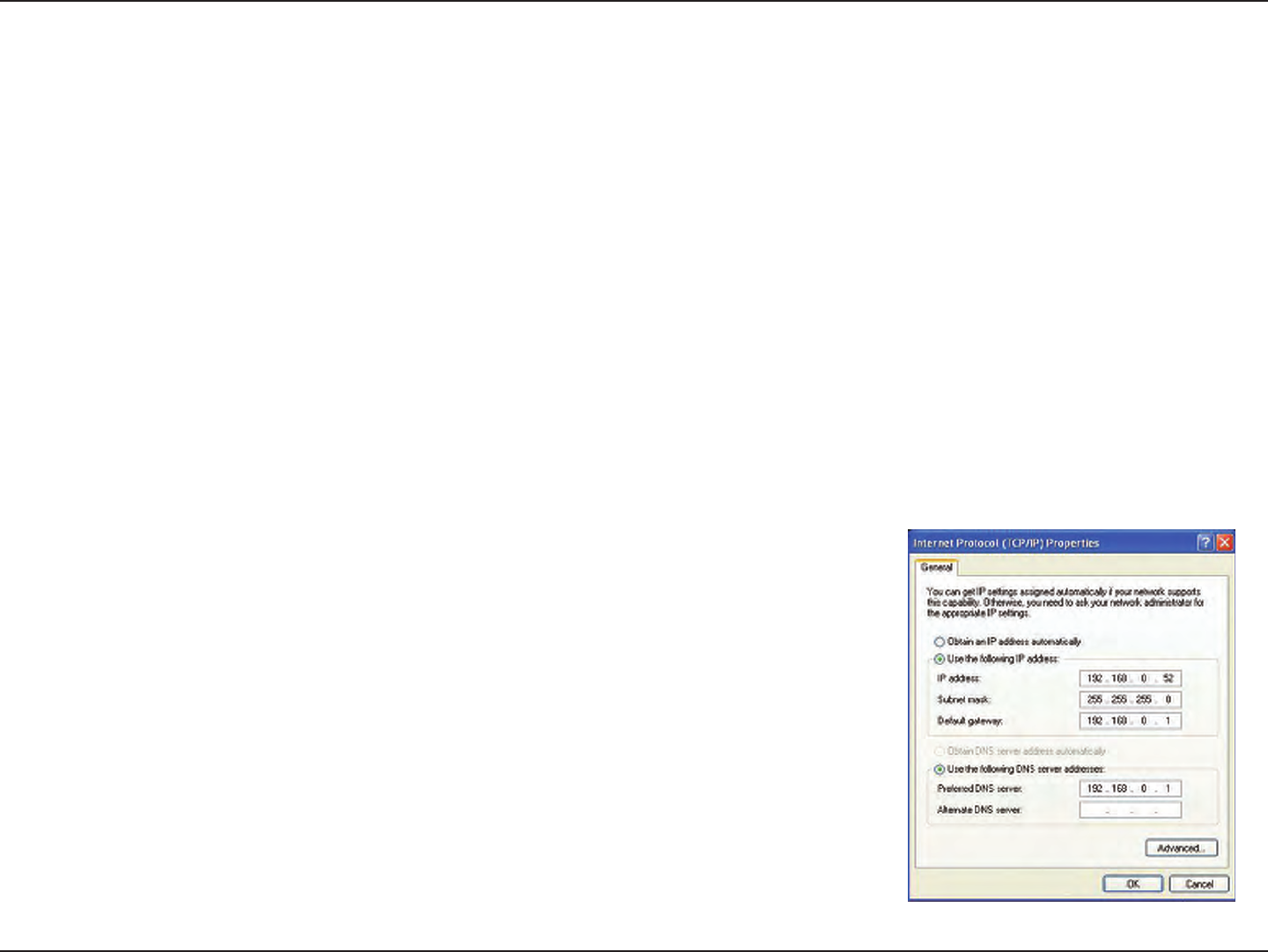
77D-Link DAP-1525 User Manual
Appendix B - Networking Basics
Statically Assign an IP address
If you are not using a DHCP capable gateway/Access Point, or you need to assign a static IP address, please follow
the steps below:
Step 1
Windows Vista® - Click on Start > Control Panel > Network and Internet > Network and Sharing Center > Manage
Network Connections.
Windows® XP - Click on Start > Control Panel > Network Connections.
Windows® 2000 - From the desktop, right-click My Network Places > Properties.
Step 2
Right-click on the Local Area Connection which represents your network adapter and select Properties.
Step 3
Highlight Internet Protocol (TCP/IP) and click Properties.
Step 4
Click Use the following IP address and enter an IP address that is on the same
subnet as your network or the LAN IP address on your Access Point.
Example: If the Access Point´s LAN IP address is 192.168.0.50, make your IP
address 192.168.0.X where X is a number between 1 and 99, except 50. Make sure
that the number you choose is not in use on the network. Set Default Gateway the
same as the LAN IP address of your Access Point (192.168.0.50).
Set Primary DNS the same as the LAN IP address of your Access Point
(192.168.0.50). The Secondary DNS is not needed or you may enter a DNS server
from your ISP.
Step 5
Click OK twice to save your settings.
Federal Communication Commission Interference Statement
This equipment has been tested and found to comply with the limits for a Class B digital device, pursuant to
Part 15 of the FCC Rules. These limits are designed to provide reasonable protection against harmful
interference in a residential installation. This equipment generates, uses and can radiate radio frequency
energy and, if not installed and used in accordance with the instructions, may cause harmful interference to
radio communications. However, there is no guarantee that interference will not occur in a particular
installation. If this equipment does cause harmful interference to radio or television reception, which can
be determined by turning the equipment off and on, the user is encouraged to try to correct the interference
by one of the following measures:
- Reorient or relocate the receiving antenna.
- Increase the separation between the equipment and receiver.
- Connect the equipment into an outlet on a circuit different from that
to which the receiver is connected.
- Consult the dealer or an experienced radio/TV technician for help.
FCC Caution: Any changes or modifications not expressly approved by the party responsible for
compliance could void the user's authority to operate this equipment.
For operation within 5.15 ~ 5.25GHz frequency range, it is restricted to indoor environment.
This device complies with Part 15 of the FCC Rules. Operation is subject to the following two conditions: (1)
This device may not cause harmful interference, and (2) this device must accept any interference received,
including interference that may cause undesired operation.
IMPORTANT NOTE:
Radiation Exposure Statement:
This equipment complies with FCC radiation exposure limits set forth for an uncontrolled environment. This
equipment should be installed and operated with minimum distance 20cm between the radiator & your
body.
This transmitter must not be co-located or operating in conjunction with any other antenna or transmitter.
Industry Canada statement
This device complies with RSS-210 of the Industry Canada Rules. Operation is subject to the following two conditions: (1)
This device may not cause harmful interference, and (2) this device must accept any interference received, including
interference that may cause undesired operation.
IMPORTANT NOTE:
Radiation Exposure Statement:
This equipment complies with IC radiation exposure limits set forth for an uncontrolled environment. This equipment
should be installed and operated with minimum distance 20cm between the radiator & your body.
Caution:
(i) the device for operation in the band 5150-5250 MHz is only for indoor use to reduce the potential for harmful
interference to co-channel mobile satellite systems;
(ii) the maximum antenna gain permitted for devices in the bands 5250-5350 MHz and 5470-5725 MHz shall comply with
the e.i.r.p. limit; and
(iii) the maximum antenna gain permitted for devices in the band 5725-5825 MHz shall comply with the e.i.r.p. limits
specified for point-to-point and non point-to-point operation as appropriate.
IMPORTANT NOTE:
Radiation Exposure Statement:
The product comply with the US/Canada portable RF exposure limit set forth for an uncontrolled environment and are
safe for intended operation as described in this manual. The further RF exposure reduction can be achieved if the product
can be kept as far as possible from the user body or set the device to lower output power if such function is available.
NOTE IMPORTANTE:
Déclaration d'exposition aux radiations:
Cet équipement est conforme aux limites d'exposition aux rayonnements IC établies pour un environnement non contrôlé.
Cet équipement doit être installé et utilisé avec un minimum de 20 cm de distance entre la source de rayonnement et
votre corps.
Avertissement:
Le guide d’utilisation des dispositifs pour réseaux locaux doit inclure des instructions précises sur les restrictions
susmentionnées, notamment :
(i) les dispositifs fonctionnant dans la bande 5 150-5 250 MHz sont réservés uniquement pour une utilisation à l’intérieur
afin de réduire les risques de brouillage préjudiciable aux systèmes de satellites mobiles utilisant les mêmes canaux;
(iii) le gain maximal d’antenne permis (pour les dispositifs utilisant la bande 5 725-5 825 MHz) doit se conformer à la
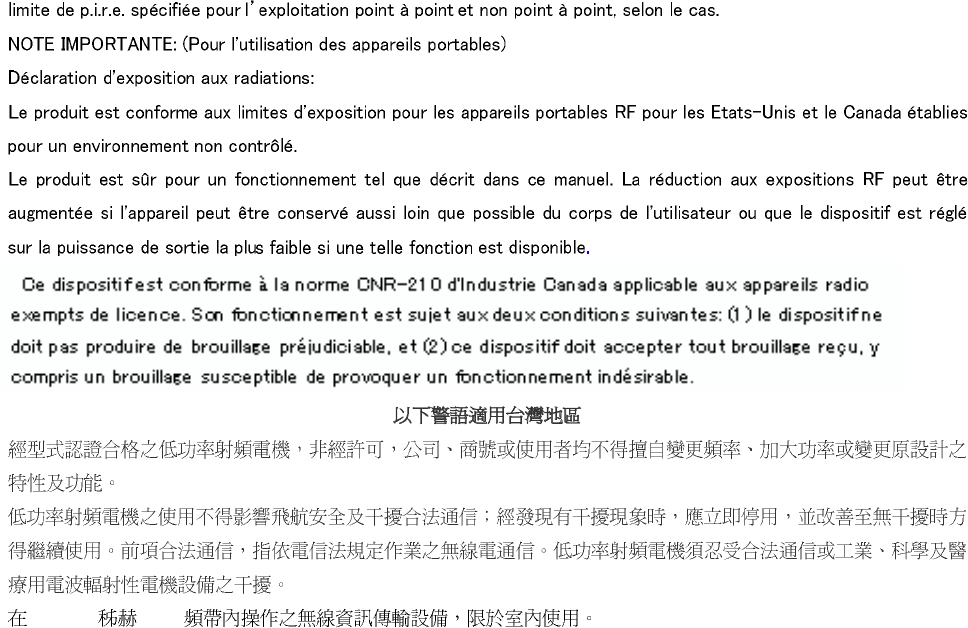
5.25-5.35 (GHz)